Environmental Issues in Construction Projects
VerifiedAdded on 2023/01/03
|20
|4522
|31
AI Summary
This article discusses the various environmental factors that can affect construction projects, including weather elements, climate change, availability of materials, technology, and location. It explores the impact of rainfall, thunderstorms, winter, and heat on construction activities. It also highlights the role of BIM (Building Information Modelling) in project delivery and how it can be used in planning, designing, and construction stages. The article provides insights into the importance of considering environmental factors and utilizing advanced technology for successful project implementation.
Contribute Materials
Your contribution can guide someone’s learning journey. Share your
documents today.
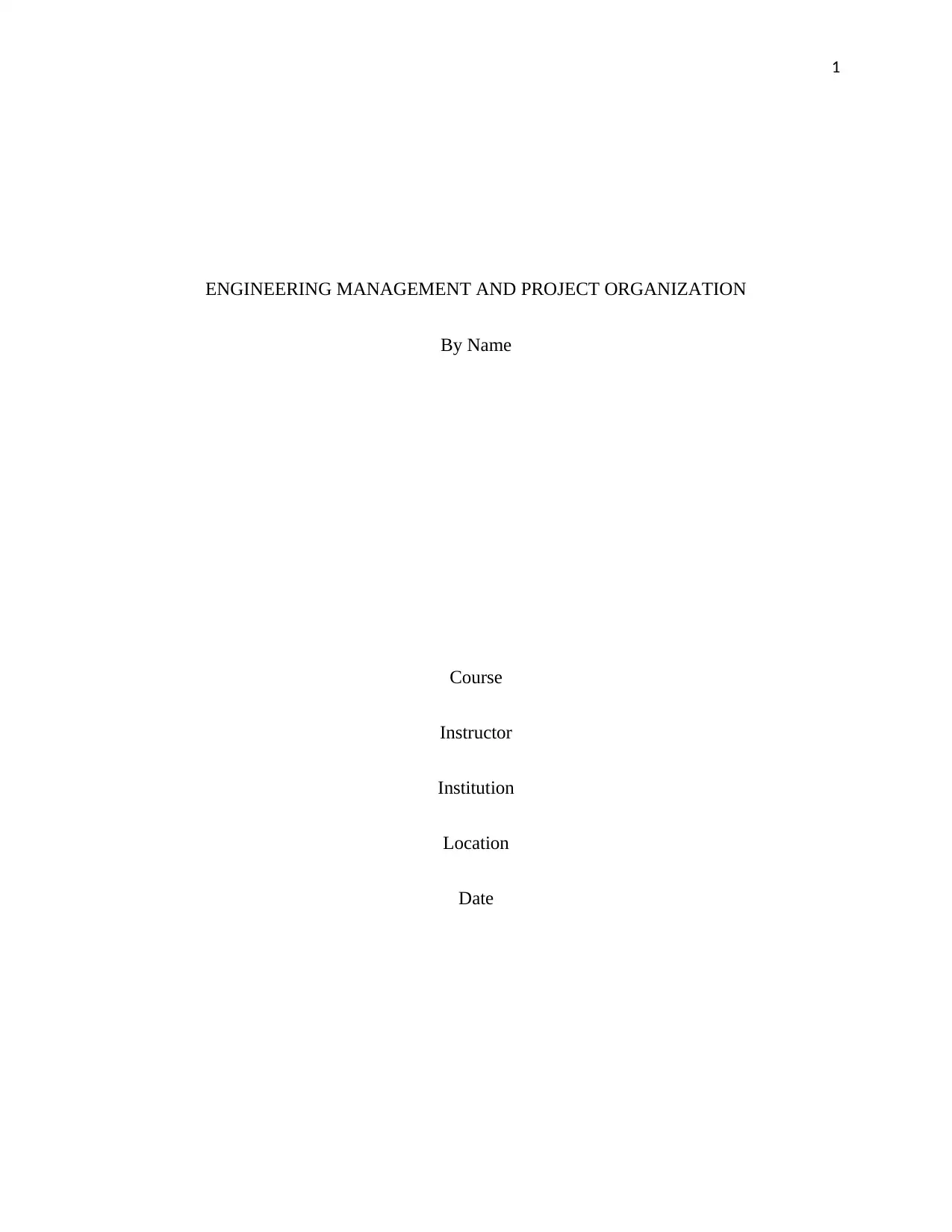
1
ENGINEERING MANAGEMENT AND PROJECT ORGANIZATION
By Name
Course
Instructor
Institution
Location
Date
ENGINEERING MANAGEMENT AND PROJECT ORGANIZATION
By Name
Course
Instructor
Institution
Location
Date
Secure Best Marks with AI Grader
Need help grading? Try our AI Grader for instant feedback on your assignments.
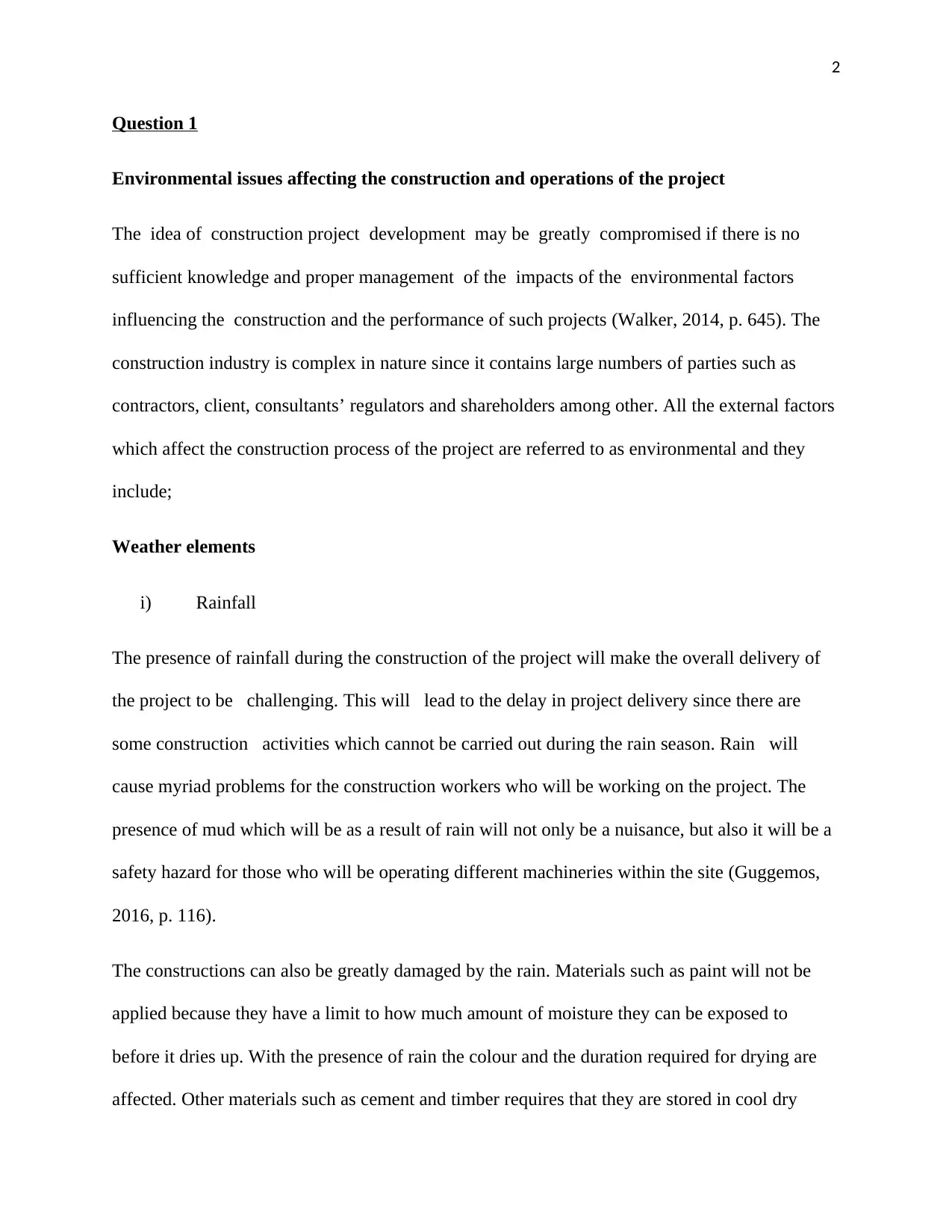
2
Question 1
Environmental issues affecting the construction and operations of the project
The idea of construction project development may be greatly compromised if there is no
sufficient knowledge and proper management of the impacts of the environmental factors
influencing the construction and the performance of such projects (Walker, 2014, p. 645). The
construction industry is complex in nature since it contains large numbers of parties such as
contractors, client, consultants’ regulators and shareholders among other. All the external factors
which affect the construction process of the project are referred to as environmental and they
include;
Weather elements
i) Rainfall
The presence of rainfall during the construction of the project will make the overall delivery of
the project to be challenging. This will lead to the delay in project delivery since there are
some construction activities which cannot be carried out during the rain season. Rain will
cause myriad problems for the construction workers who will be working on the project. The
presence of mud which will be as a result of rain will not only be a nuisance, but also it will be a
safety hazard for those who will be operating different machineries within the site (Guggemos,
2016, p. 116).
The constructions can also be greatly damaged by the rain. Materials such as paint will not be
applied because they have a limit to how much amount of moisture they can be exposed to
before it dries up. With the presence of rain the colour and the duration required for drying are
affected. Other materials such as cement and timber requires that they are stored in cool dry
Question 1
Environmental issues affecting the construction and operations of the project
The idea of construction project development may be greatly compromised if there is no
sufficient knowledge and proper management of the impacts of the environmental factors
influencing the construction and the performance of such projects (Walker, 2014, p. 645). The
construction industry is complex in nature since it contains large numbers of parties such as
contractors, client, consultants’ regulators and shareholders among other. All the external factors
which affect the construction process of the project are referred to as environmental and they
include;
Weather elements
i) Rainfall
The presence of rainfall during the construction of the project will make the overall delivery of
the project to be challenging. This will lead to the delay in project delivery since there are
some construction activities which cannot be carried out during the rain season. Rain will
cause myriad problems for the construction workers who will be working on the project. The
presence of mud which will be as a result of rain will not only be a nuisance, but also it will be a
safety hazard for those who will be operating different machineries within the site (Guggemos,
2016, p. 116).
The constructions can also be greatly damaged by the rain. Materials such as paint will not be
applied because they have a limit to how much amount of moisture they can be exposed to
before it dries up. With the presence of rain the colour and the duration required for drying are
affected. Other materials such as cement and timber requires that they are stored in cool dry
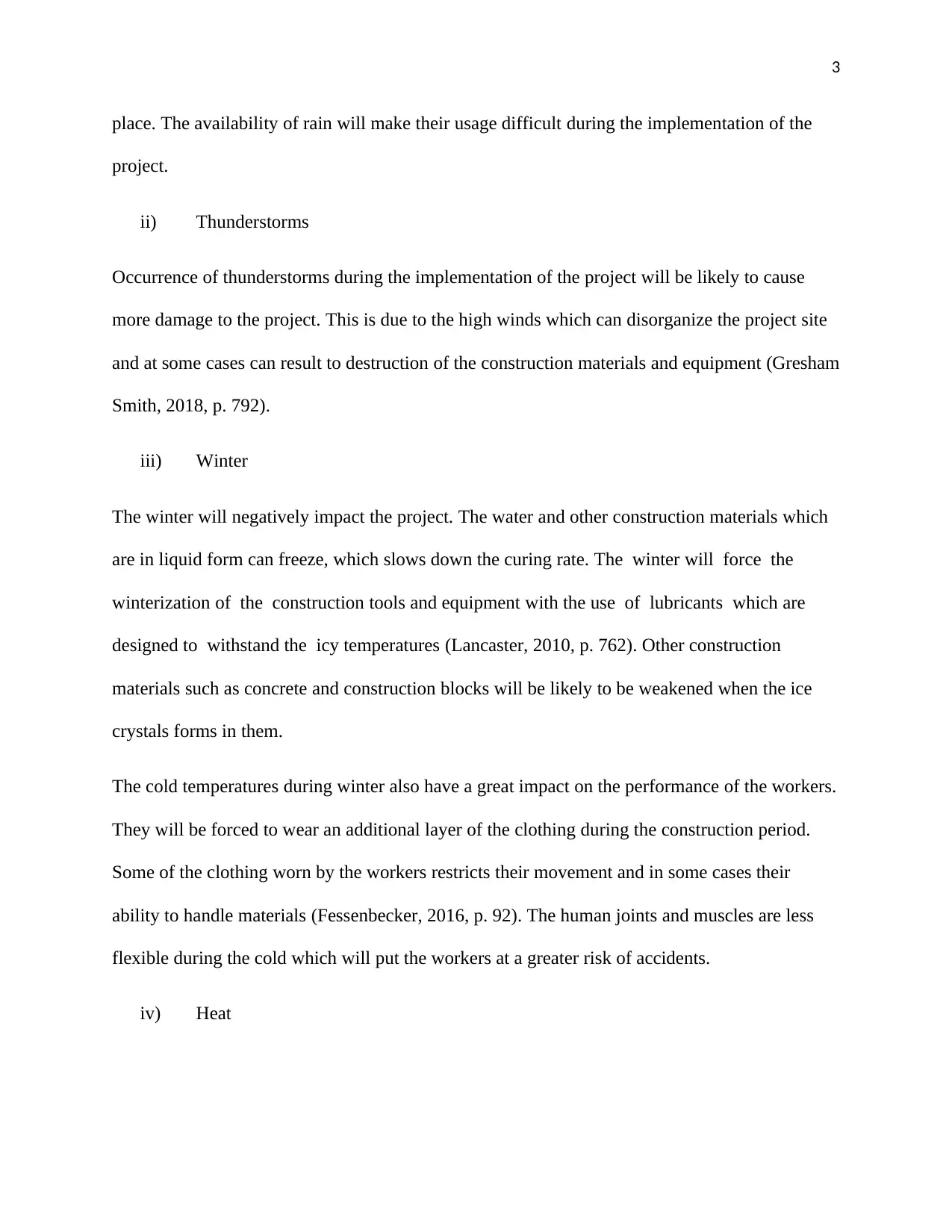
3
place. The availability of rain will make their usage difficult during the implementation of the
project.
ii) Thunderstorms
Occurrence of thunderstorms during the implementation of the project will be likely to cause
more damage to the project. This is due to the high winds which can disorganize the project site
and at some cases can result to destruction of the construction materials and equipment (Gresham
Smith, 2018, p. 792).
iii) Winter
The winter will negatively impact the project. The water and other construction materials which
are in liquid form can freeze, which slows down the curing rate. The winter will force the
winterization of the construction tools and equipment with the use of lubricants which are
designed to withstand the icy temperatures (Lancaster, 2010, p. 762). Other construction
materials such as concrete and construction blocks will be likely to be weakened when the ice
crystals forms in them.
The cold temperatures during winter also have a great impact on the performance of the workers.
They will be forced to wear an additional layer of the clothing during the construction period.
Some of the clothing worn by the workers restricts their movement and in some cases their
ability to handle materials (Fessenbecker, 2016, p. 92). The human joints and muscles are less
flexible during the cold which will put the workers at a greater risk of accidents.
iv) Heat
place. The availability of rain will make their usage difficult during the implementation of the
project.
ii) Thunderstorms
Occurrence of thunderstorms during the implementation of the project will be likely to cause
more damage to the project. This is due to the high winds which can disorganize the project site
and at some cases can result to destruction of the construction materials and equipment (Gresham
Smith, 2018, p. 792).
iii) Winter
The winter will negatively impact the project. The water and other construction materials which
are in liquid form can freeze, which slows down the curing rate. The winter will force the
winterization of the construction tools and equipment with the use of lubricants which are
designed to withstand the icy temperatures (Lancaster, 2010, p. 762). Other construction
materials such as concrete and construction blocks will be likely to be weakened when the ice
crystals forms in them.
The cold temperatures during winter also have a great impact on the performance of the workers.
They will be forced to wear an additional layer of the clothing during the construction period.
Some of the clothing worn by the workers restricts their movement and in some cases their
ability to handle materials (Fessenbecker, 2016, p. 92). The human joints and muscles are less
flexible during the cold which will put the workers at a greater risk of accidents.
iv) Heat
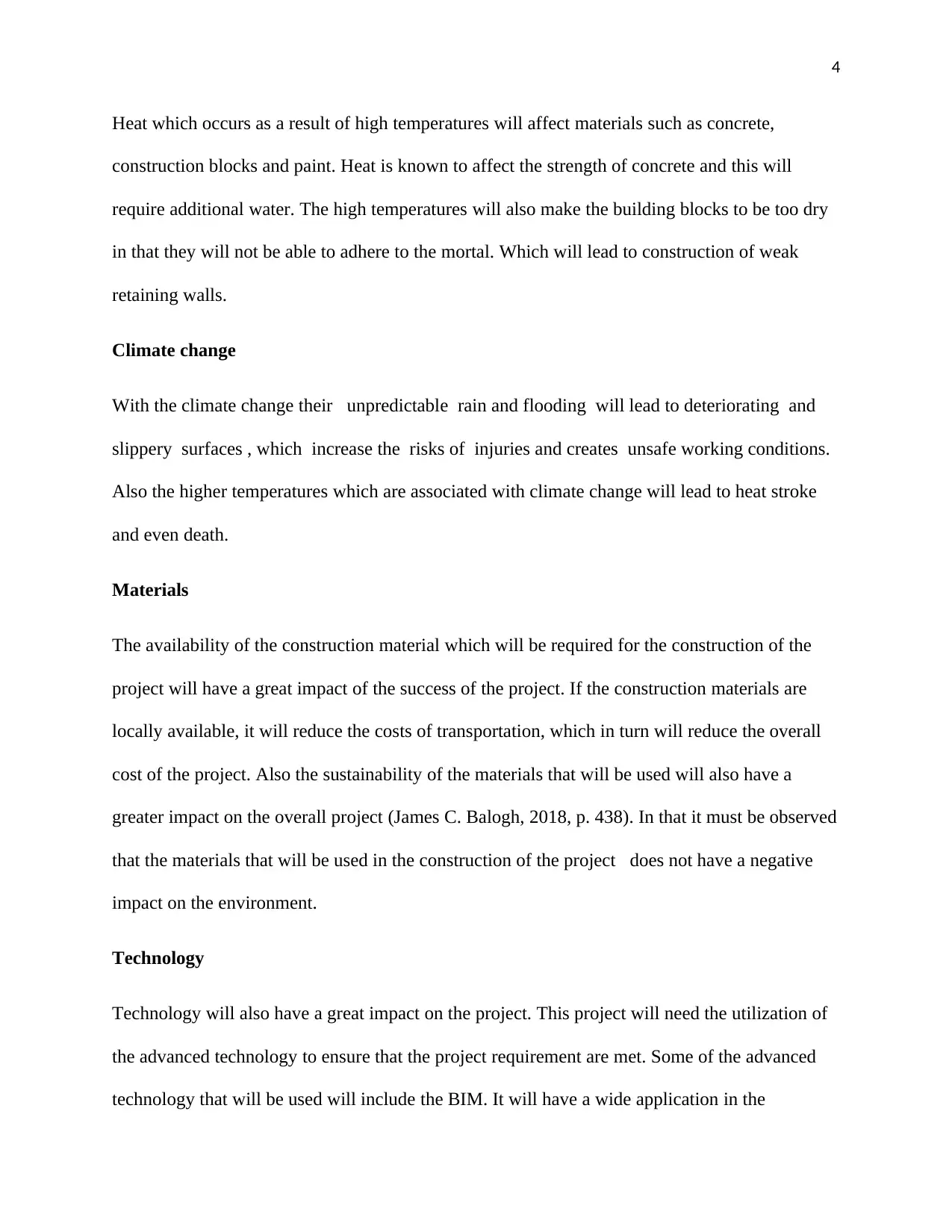
4
Heat which occurs as a result of high temperatures will affect materials such as concrete,
construction blocks and paint. Heat is known to affect the strength of concrete and this will
require additional water. The high temperatures will also make the building blocks to be too dry
in that they will not be able to adhere to the mortal. Which will lead to construction of weak
retaining walls.
Climate change
With the climate change their unpredictable rain and flooding will lead to deteriorating and
slippery surfaces , which increase the risks of injuries and creates unsafe working conditions.
Also the higher temperatures which are associated with climate change will lead to heat stroke
and even death.
Materials
The availability of the construction material which will be required for the construction of the
project will have a great impact of the success of the project. If the construction materials are
locally available, it will reduce the costs of transportation, which in turn will reduce the overall
cost of the project. Also the sustainability of the materials that will be used will also have a
greater impact on the overall project (James C. Balogh, 2018, p. 438). In that it must be observed
that the materials that will be used in the construction of the project does not have a negative
impact on the environment.
Technology
Technology will also have a great impact on the project. This project will need the utilization of
the advanced technology to ensure that the project requirement are met. Some of the advanced
technology that will be used will include the BIM. It will have a wide application in the
Heat which occurs as a result of high temperatures will affect materials such as concrete,
construction blocks and paint. Heat is known to affect the strength of concrete and this will
require additional water. The high temperatures will also make the building blocks to be too dry
in that they will not be able to adhere to the mortal. Which will lead to construction of weak
retaining walls.
Climate change
With the climate change their unpredictable rain and flooding will lead to deteriorating and
slippery surfaces , which increase the risks of injuries and creates unsafe working conditions.
Also the higher temperatures which are associated with climate change will lead to heat stroke
and even death.
Materials
The availability of the construction material which will be required for the construction of the
project will have a great impact of the success of the project. If the construction materials are
locally available, it will reduce the costs of transportation, which in turn will reduce the overall
cost of the project. Also the sustainability of the materials that will be used will also have a
greater impact on the overall project (James C. Balogh, 2018, p. 438). In that it must be observed
that the materials that will be used in the construction of the project does not have a negative
impact on the environment.
Technology
Technology will also have a great impact on the project. This project will need the utilization of
the advanced technology to ensure that the project requirement are met. Some of the advanced
technology that will be used will include the BIM. It will have a wide application in the
Secure Best Marks with AI Grader
Need help grading? Try our AI Grader for instant feedback on your assignments.
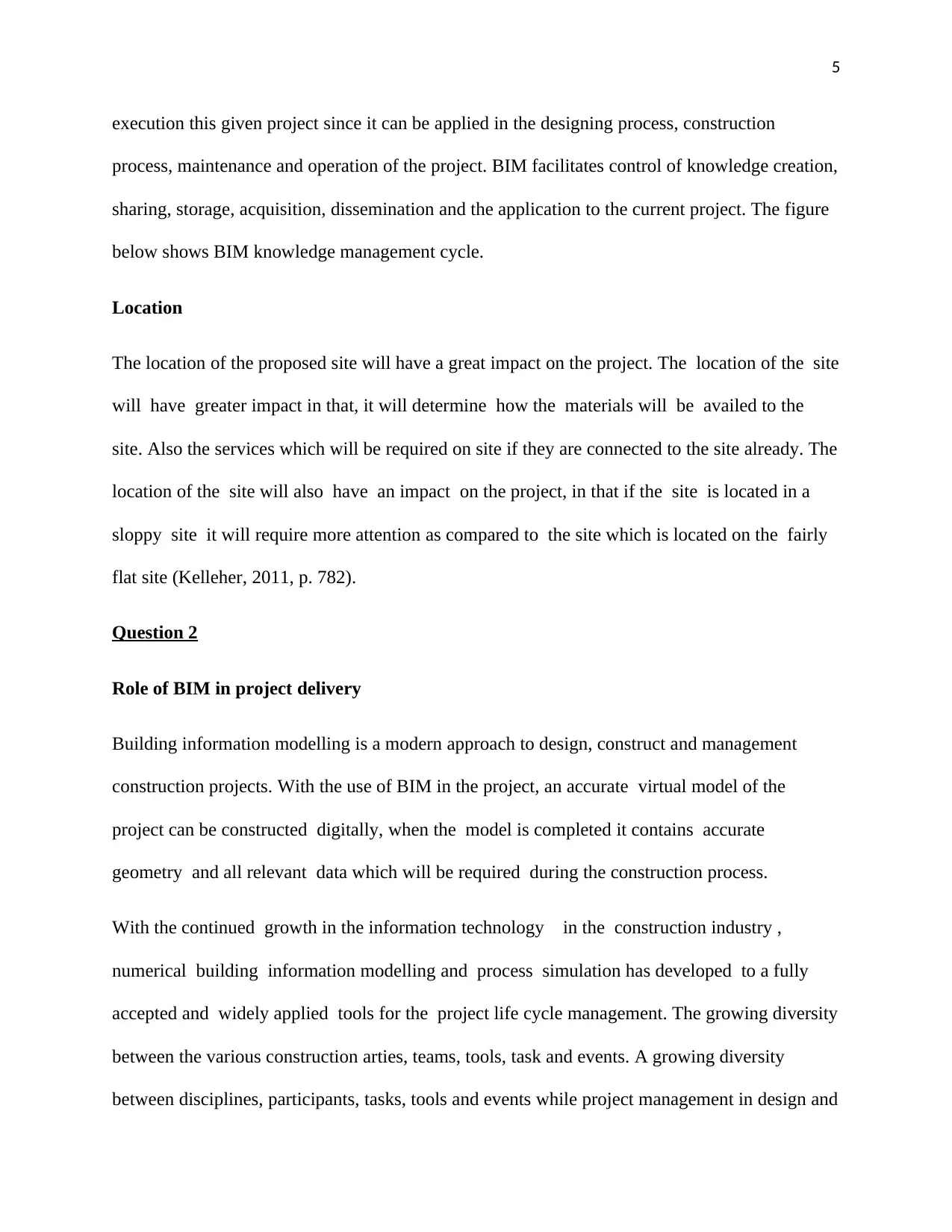
5
execution this given project since it can be applied in the designing process, construction
process, maintenance and operation of the project. BIM facilitates control of knowledge creation,
sharing, storage, acquisition, dissemination and the application to the current project. The figure
below shows BIM knowledge management cycle.
Location
The location of the proposed site will have a great impact on the project. The location of the site
will have greater impact in that, it will determine how the materials will be availed to the
site. Also the services which will be required on site if they are connected to the site already. The
location of the site will also have an impact on the project, in that if the site is located in a
sloppy site it will require more attention as compared to the site which is located on the fairly
flat site (Kelleher, 2011, p. 782).
Question 2
Role of BIM in project delivery
Building information modelling is a modern approach to design, construct and management
construction projects. With the use of BIM in the project, an accurate virtual model of the
project can be constructed digitally, when the model is completed it contains accurate
geometry and all relevant data which will be required during the construction process.
With the continued growth in the information technology in the construction industry ,
numerical building information modelling and process simulation has developed to a fully
accepted and widely applied tools for the project life cycle management. The growing diversity
between the various construction arties, teams, tools, task and events. A growing diversity
between disciplines, participants, tasks, tools and events while project management in design and
execution this given project since it can be applied in the designing process, construction
process, maintenance and operation of the project. BIM facilitates control of knowledge creation,
sharing, storage, acquisition, dissemination and the application to the current project. The figure
below shows BIM knowledge management cycle.
Location
The location of the proposed site will have a great impact on the project. The location of the site
will have greater impact in that, it will determine how the materials will be availed to the
site. Also the services which will be required on site if they are connected to the site already. The
location of the site will also have an impact on the project, in that if the site is located in a
sloppy site it will require more attention as compared to the site which is located on the fairly
flat site (Kelleher, 2011, p. 782).
Question 2
Role of BIM in project delivery
Building information modelling is a modern approach to design, construct and management
construction projects. With the use of BIM in the project, an accurate virtual model of the
project can be constructed digitally, when the model is completed it contains accurate
geometry and all relevant data which will be required during the construction process.
With the continued growth in the information technology in the construction industry ,
numerical building information modelling and process simulation has developed to a fully
accepted and widely applied tools for the project life cycle management. The growing diversity
between the various construction arties, teams, tools, task and events. A growing diversity
between disciplines, participants, tasks, tools and events while project management in design and
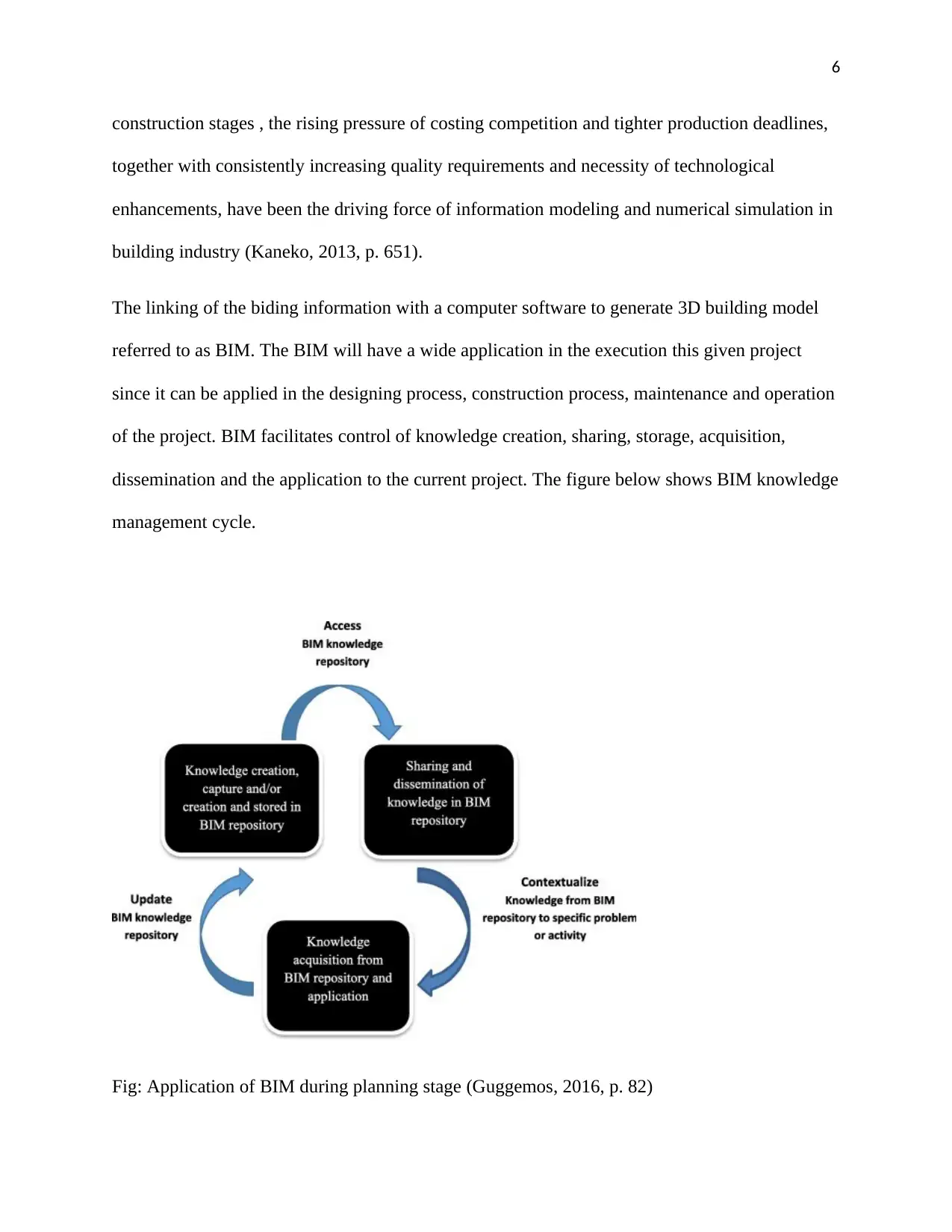
6
construction stages , the rising pressure of costing competition and tighter production deadlines,
together with consistently increasing quality requirements and necessity of technological
enhancements, have been the driving force of information modeling and numerical simulation in
building industry (Kaneko, 2013, p. 651).
The linking of the biding information with a computer software to generate 3D building model
referred to as BIM. The BIM will have a wide application in the execution this given project
since it can be applied in the designing process, construction process, maintenance and operation
of the project. BIM facilitates control of knowledge creation, sharing, storage, acquisition,
dissemination and the application to the current project. The figure below shows BIM knowledge
management cycle.
Fig: Application of BIM during planning stage (Guggemos, 2016, p. 82)
construction stages , the rising pressure of costing competition and tighter production deadlines,
together with consistently increasing quality requirements and necessity of technological
enhancements, have been the driving force of information modeling and numerical simulation in
building industry (Kaneko, 2013, p. 651).
The linking of the biding information with a computer software to generate 3D building model
referred to as BIM. The BIM will have a wide application in the execution this given project
since it can be applied in the designing process, construction process, maintenance and operation
of the project. BIM facilitates control of knowledge creation, sharing, storage, acquisition,
dissemination and the application to the current project. The figure below shows BIM knowledge
management cycle.
Fig: Application of BIM during planning stage (Guggemos, 2016, p. 82)
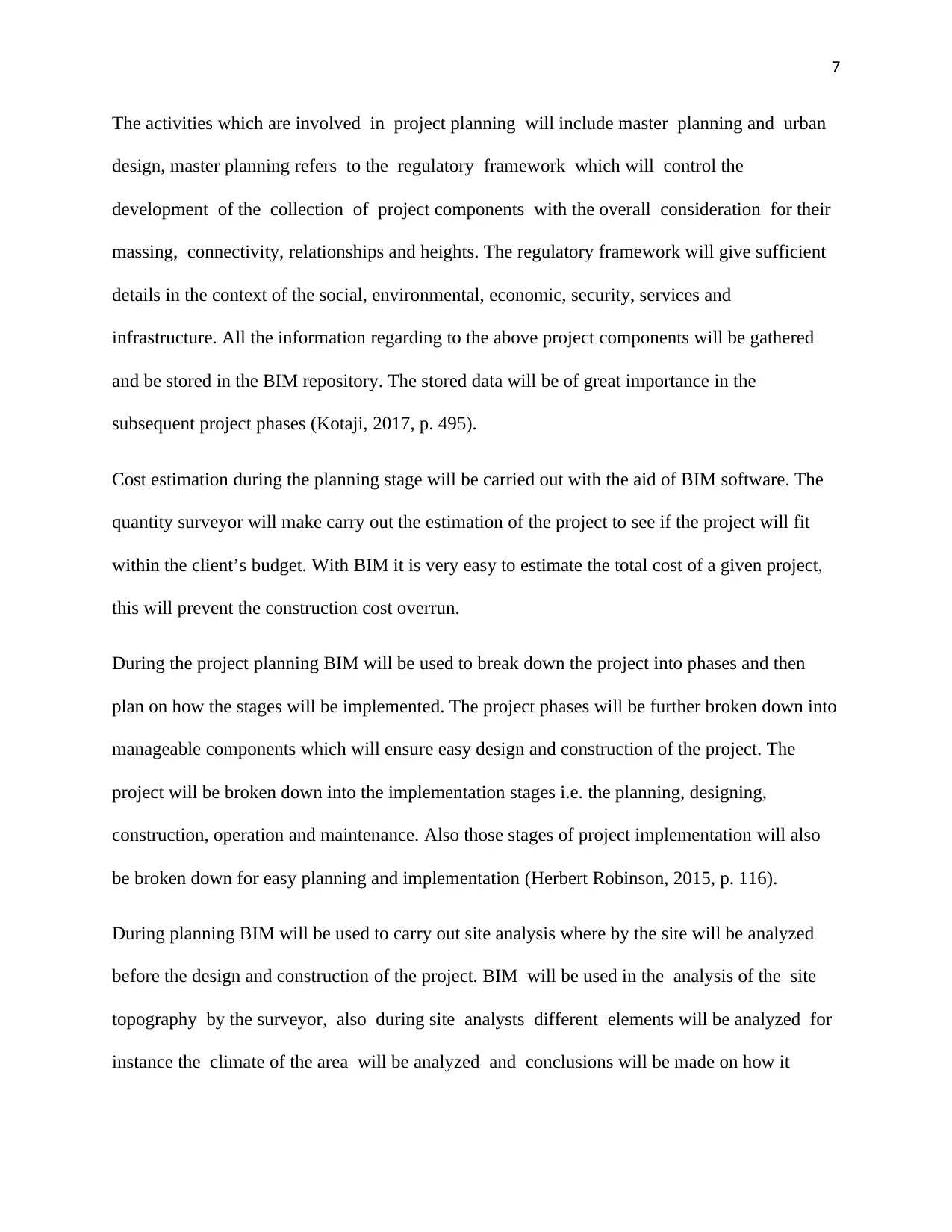
7
The activities which are involved in project planning will include master planning and urban
design, master planning refers to the regulatory framework which will control the
development of the collection of project components with the overall consideration for their
massing, connectivity, relationships and heights. The regulatory framework will give sufficient
details in the context of the social, environmental, economic, security, services and
infrastructure. All the information regarding to the above project components will be gathered
and be stored in the BIM repository. The stored data will be of great importance in the
subsequent project phases (Kotaji, 2017, p. 495).
Cost estimation during the planning stage will be carried out with the aid of BIM software. The
quantity surveyor will make carry out the estimation of the project to see if the project will fit
within the client’s budget. With BIM it is very easy to estimate the total cost of a given project,
this will prevent the construction cost overrun.
During the project planning BIM will be used to break down the project into phases and then
plan on how the stages will be implemented. The project phases will be further broken down into
manageable components which will ensure easy design and construction of the project. The
project will be broken down into the implementation stages i.e. the planning, designing,
construction, operation and maintenance. Also those stages of project implementation will also
be broken down for easy planning and implementation (Herbert Robinson, 2015, p. 116).
During planning BIM will be used to carry out site analysis where by the site will be analyzed
before the design and construction of the project. BIM will be used in the analysis of the site
topography by the surveyor, also during site analysts different elements will be analyzed for
instance the climate of the area will be analyzed and conclusions will be made on how it
The activities which are involved in project planning will include master planning and urban
design, master planning refers to the regulatory framework which will control the
development of the collection of project components with the overall consideration for their
massing, connectivity, relationships and heights. The regulatory framework will give sufficient
details in the context of the social, environmental, economic, security, services and
infrastructure. All the information regarding to the above project components will be gathered
and be stored in the BIM repository. The stored data will be of great importance in the
subsequent project phases (Kotaji, 2017, p. 495).
Cost estimation during the planning stage will be carried out with the aid of BIM software. The
quantity surveyor will make carry out the estimation of the project to see if the project will fit
within the client’s budget. With BIM it is very easy to estimate the total cost of a given project,
this will prevent the construction cost overrun.
During the project planning BIM will be used to break down the project into phases and then
plan on how the stages will be implemented. The project phases will be further broken down into
manageable components which will ensure easy design and construction of the project. The
project will be broken down into the implementation stages i.e. the planning, designing,
construction, operation and maintenance. Also those stages of project implementation will also
be broken down for easy planning and implementation (Herbert Robinson, 2015, p. 116).
During planning BIM will be used to carry out site analysis where by the site will be analyzed
before the design and construction of the project. BIM will be used in the analysis of the site
topography by the surveyor, also during site analysts different elements will be analyzed for
instance the climate of the area will be analyzed and conclusions will be made on how it
Paraphrase This Document
Need a fresh take? Get an instant paraphrase of this document with our AI Paraphraser
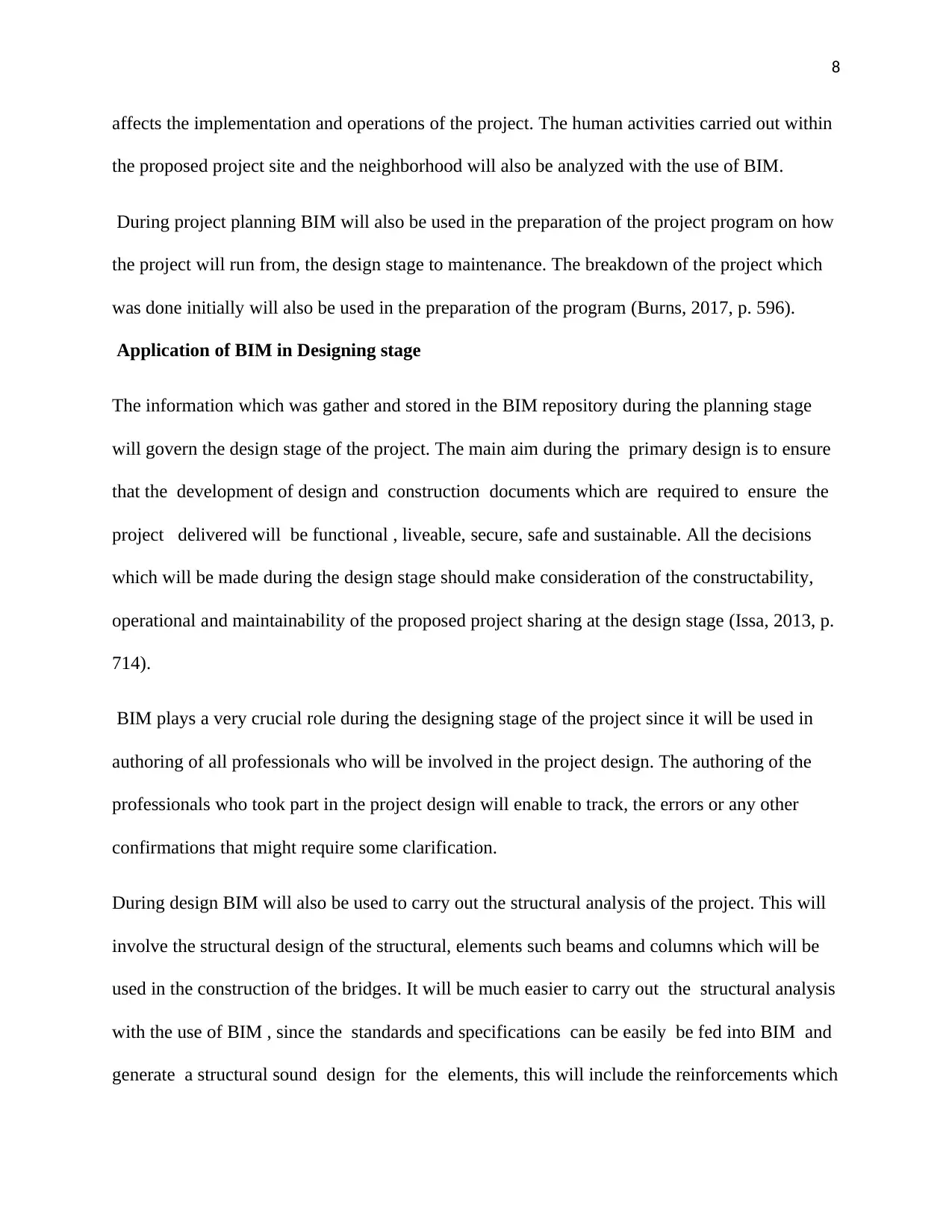
8
affects the implementation and operations of the project. The human activities carried out within
the proposed project site and the neighborhood will also be analyzed with the use of BIM.
During project planning BIM will also be used in the preparation of the project program on how
the project will run from, the design stage to maintenance. The breakdown of the project which
was done initially will also be used in the preparation of the program (Burns, 2017, p. 596).
Application of BIM in Designing stage
The information which was gather and stored in the BIM repository during the planning stage
will govern the design stage of the project. The main aim during the primary design is to ensure
that the development of design and construction documents which are required to ensure the
project delivered will be functional , liveable, secure, safe and sustainable. All the decisions
which will be made during the design stage should make consideration of the constructability,
operational and maintainability of the proposed project sharing at the design stage (Issa, 2013, p.
714).
BIM plays a very crucial role during the designing stage of the project since it will be used in
authoring of all professionals who will be involved in the project design. The authoring of the
professionals who took part in the project design will enable to track, the errors or any other
confirmations that might require some clarification.
During design BIM will also be used to carry out the structural analysis of the project. This will
involve the structural design of the structural, elements such beams and columns which will be
used in the construction of the bridges. It will be much easier to carry out the structural analysis
with the use of BIM , since the standards and specifications can be easily be fed into BIM and
generate a structural sound design for the elements, this will include the reinforcements which
affects the implementation and operations of the project. The human activities carried out within
the proposed project site and the neighborhood will also be analyzed with the use of BIM.
During project planning BIM will also be used in the preparation of the project program on how
the project will run from, the design stage to maintenance. The breakdown of the project which
was done initially will also be used in the preparation of the program (Burns, 2017, p. 596).
Application of BIM in Designing stage
The information which was gather and stored in the BIM repository during the planning stage
will govern the design stage of the project. The main aim during the primary design is to ensure
that the development of design and construction documents which are required to ensure the
project delivered will be functional , liveable, secure, safe and sustainable. All the decisions
which will be made during the design stage should make consideration of the constructability,
operational and maintainability of the proposed project sharing at the design stage (Issa, 2013, p.
714).
BIM plays a very crucial role during the designing stage of the project since it will be used in
authoring of all professionals who will be involved in the project design. The authoring of the
professionals who took part in the project design will enable to track, the errors or any other
confirmations that might require some clarification.
During design BIM will also be used to carry out the structural analysis of the project. This will
involve the structural design of the structural, elements such beams and columns which will be
used in the construction of the bridges. It will be much easier to carry out the structural analysis
with the use of BIM , since the standards and specifications can be easily be fed into BIM and
generate a structural sound design for the elements, this will include the reinforcements which
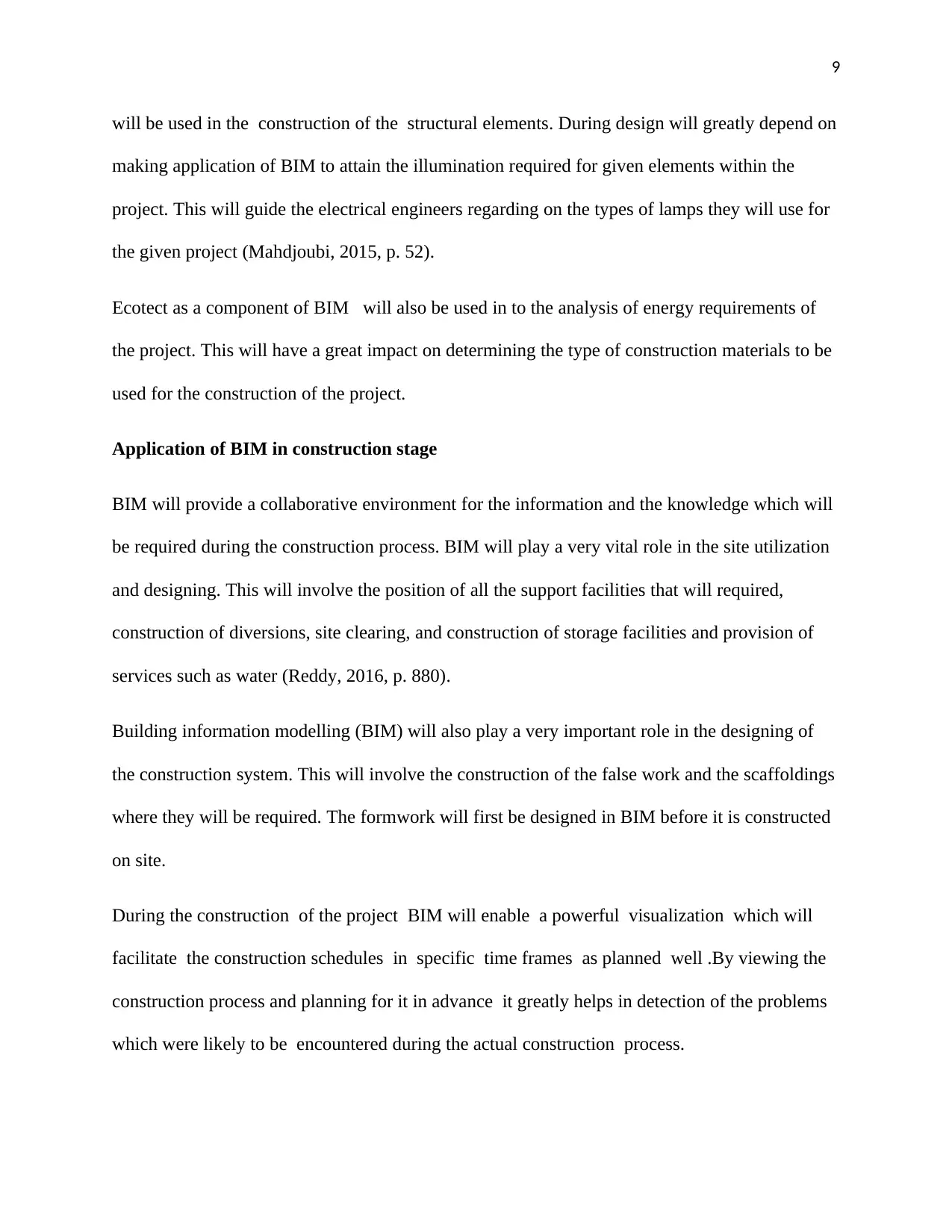
9
will be used in the construction of the structural elements. During design will greatly depend on
making application of BIM to attain the illumination required for given elements within the
project. This will guide the electrical engineers regarding on the types of lamps they will use for
the given project (Mahdjoubi, 2015, p. 52).
Ecotect as a component of BIM will also be used in to the analysis of energy requirements of
the project. This will have a great impact on determining the type of construction materials to be
used for the construction of the project.
Application of BIM in construction stage
BIM will provide a collaborative environment for the information and the knowledge which will
be required during the construction process. BIM will play a very vital role in the site utilization
and designing. This will involve the position of all the support facilities that will required,
construction of diversions, site clearing, and construction of storage facilities and provision of
services such as water (Reddy, 2016, p. 880).
Building information modelling (BIM) will also play a very important role in the designing of
the construction system. This will involve the construction of the false work and the scaffoldings
where they will be required. The formwork will first be designed in BIM before it is constructed
on site.
During the construction of the project BIM will enable a powerful visualization which will
facilitate the construction schedules in specific time frames as planned well .By viewing the
construction process and planning for it in advance it greatly helps in detection of the problems
which were likely to be encountered during the actual construction process.
will be used in the construction of the structural elements. During design will greatly depend on
making application of BIM to attain the illumination required for given elements within the
project. This will guide the electrical engineers regarding on the types of lamps they will use for
the given project (Mahdjoubi, 2015, p. 52).
Ecotect as a component of BIM will also be used in to the analysis of energy requirements of
the project. This will have a great impact on determining the type of construction materials to be
used for the construction of the project.
Application of BIM in construction stage
BIM will provide a collaborative environment for the information and the knowledge which will
be required during the construction process. BIM will play a very vital role in the site utilization
and designing. This will involve the position of all the support facilities that will required,
construction of diversions, site clearing, and construction of storage facilities and provision of
services such as water (Reddy, 2016, p. 880).
Building information modelling (BIM) will also play a very important role in the designing of
the construction system. This will involve the construction of the false work and the scaffoldings
where they will be required. The formwork will first be designed in BIM before it is constructed
on site.
During the construction of the project BIM will enable a powerful visualization which will
facilitate the construction schedules in specific time frames as planned well .By viewing the
construction process and planning for it in advance it greatly helps in detection of the problems
which were likely to be encountered during the actual construction process.
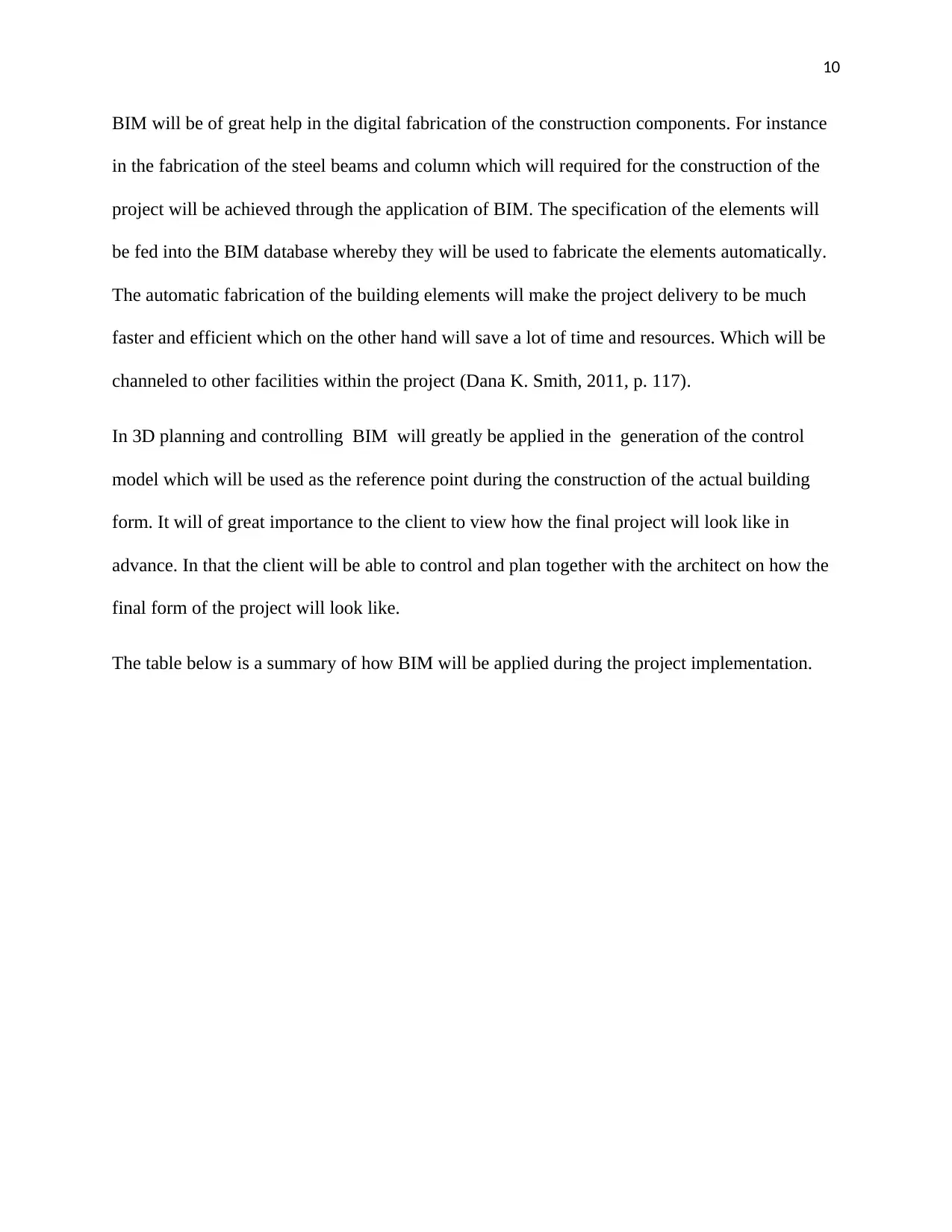
10
BIM will be of great help in the digital fabrication of the construction components. For instance
in the fabrication of the steel beams and column which will required for the construction of the
project will be achieved through the application of BIM. The specification of the elements will
be fed into the BIM database whereby they will be used to fabricate the elements automatically.
The automatic fabrication of the building elements will make the project delivery to be much
faster and efficient which on the other hand will save a lot of time and resources. Which will be
channeled to other facilities within the project (Dana K. Smith, 2011, p. 117).
In 3D planning and controlling BIM will greatly be applied in the generation of the control
model which will be used as the reference point during the construction of the actual building
form. It will of great importance to the client to view how the final project will look like in
advance. In that the client will be able to control and plan together with the architect on how the
final form of the project will look like.
The table below is a summary of how BIM will be applied during the project implementation.
BIM will be of great help in the digital fabrication of the construction components. For instance
in the fabrication of the steel beams and column which will required for the construction of the
project will be achieved through the application of BIM. The specification of the elements will
be fed into the BIM database whereby they will be used to fabricate the elements automatically.
The automatic fabrication of the building elements will make the project delivery to be much
faster and efficient which on the other hand will save a lot of time and resources. Which will be
channeled to other facilities within the project (Dana K. Smith, 2011, p. 117).
In 3D planning and controlling BIM will greatly be applied in the generation of the control
model which will be used as the reference point during the construction of the actual building
form. It will of great importance to the client to view how the final project will look like in
advance. In that the client will be able to control and plan together with the architect on how the
final form of the project will look like.
The table below is a summary of how BIM will be applied during the project implementation.
Secure Best Marks with AI Grader
Need help grading? Try our AI Grader for instant feedback on your assignments.
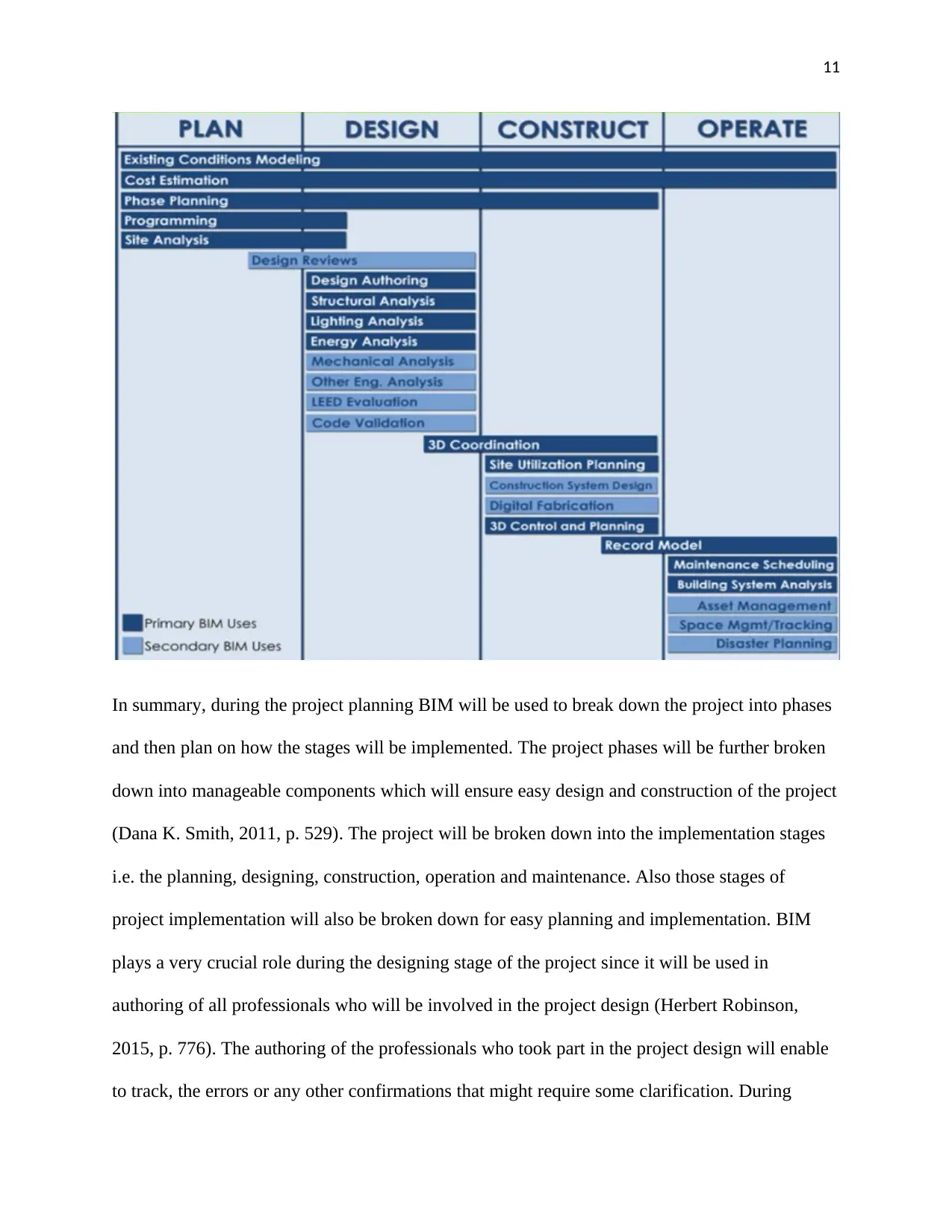
11
In summary, during the project planning BIM will be used to break down the project into phases
and then plan on how the stages will be implemented. The project phases will be further broken
down into manageable components which will ensure easy design and construction of the project
(Dana K. Smith, 2011, p. 529). The project will be broken down into the implementation stages
i.e. the planning, designing, construction, operation and maintenance. Also those stages of
project implementation will also be broken down for easy planning and implementation. BIM
plays a very crucial role during the designing stage of the project since it will be used in
authoring of all professionals who will be involved in the project design (Herbert Robinson,
2015, p. 776). The authoring of the professionals who took part in the project design will enable
to track, the errors or any other confirmations that might require some clarification. During
In summary, during the project planning BIM will be used to break down the project into phases
and then plan on how the stages will be implemented. The project phases will be further broken
down into manageable components which will ensure easy design and construction of the project
(Dana K. Smith, 2011, p. 529). The project will be broken down into the implementation stages
i.e. the planning, designing, construction, operation and maintenance. Also those stages of
project implementation will also be broken down for easy planning and implementation. BIM
plays a very crucial role during the designing stage of the project since it will be used in
authoring of all professionals who will be involved in the project design (Herbert Robinson,
2015, p. 776). The authoring of the professionals who took part in the project design will enable
to track, the errors or any other confirmations that might require some clarification. During
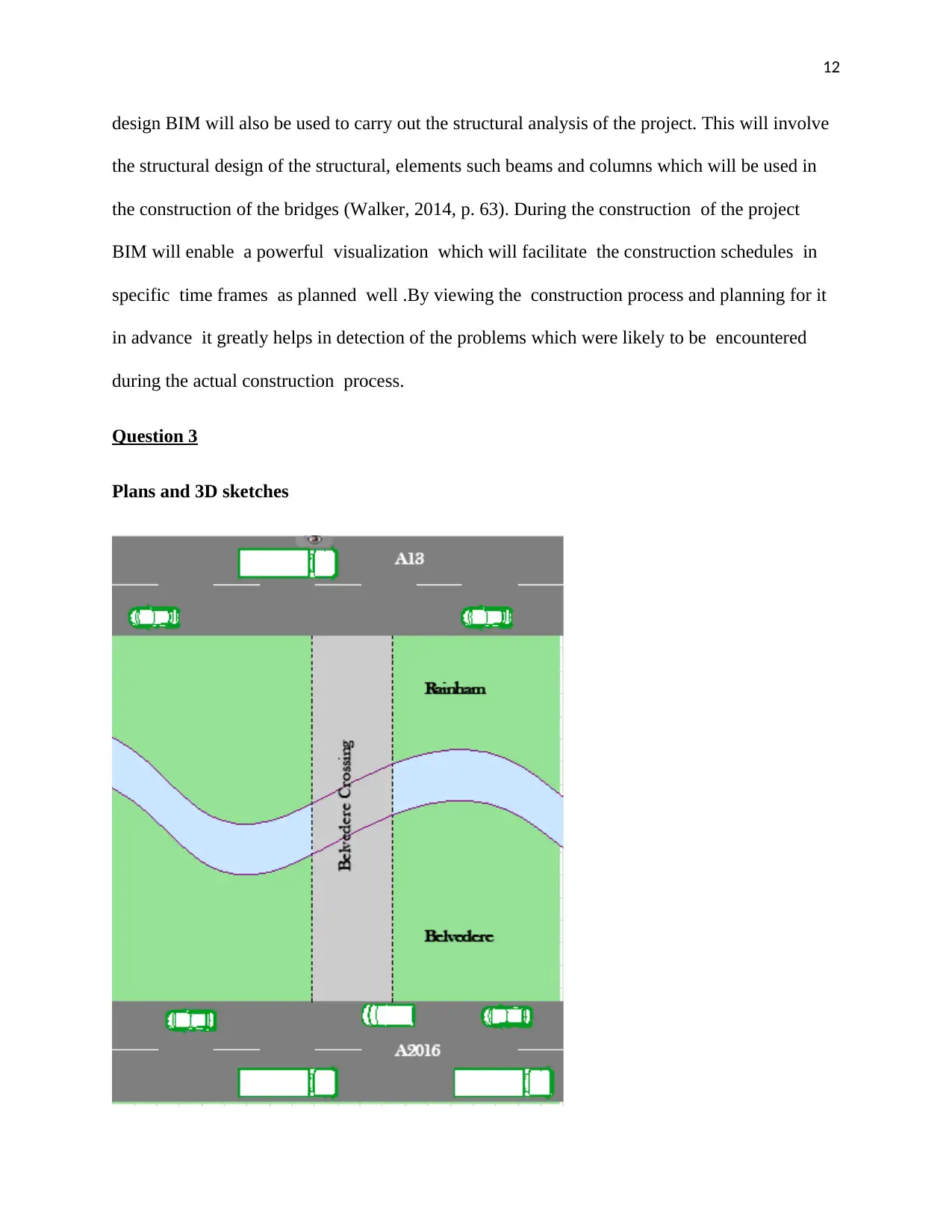
12
design BIM will also be used to carry out the structural analysis of the project. This will involve
the structural design of the structural, elements such beams and columns which will be used in
the construction of the bridges (Walker, 2014, p. 63). During the construction of the project
BIM will enable a powerful visualization which will facilitate the construction schedules in
specific time frames as planned well .By viewing the construction process and planning for it
in advance it greatly helps in detection of the problems which were likely to be encountered
during the actual construction process.
Question 3
Plans and 3D sketches
design BIM will also be used to carry out the structural analysis of the project. This will involve
the structural design of the structural, elements such beams and columns which will be used in
the construction of the bridges (Walker, 2014, p. 63). During the construction of the project
BIM will enable a powerful visualization which will facilitate the construction schedules in
specific time frames as planned well .By viewing the construction process and planning for it
in advance it greatly helps in detection of the problems which were likely to be encountered
during the actual construction process.
Question 3
Plans and 3D sketches
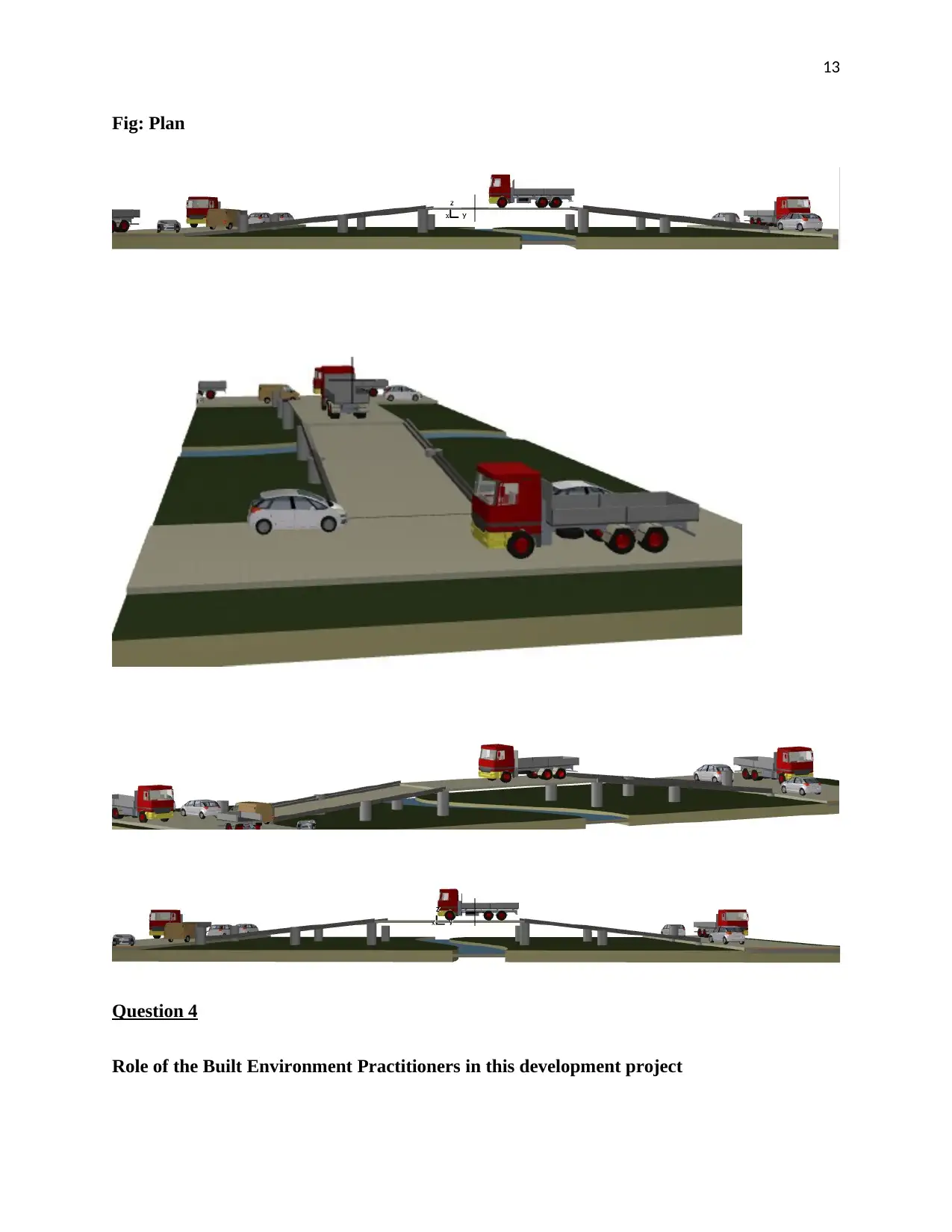
13
Fig: Plan
Question 4
Role of the Built Environment Practitioners in this development project
Fig: Plan
Question 4
Role of the Built Environment Practitioners in this development project
Paraphrase This Document
Need a fresh take? Get an instant paraphrase of this document with our AI Paraphraser
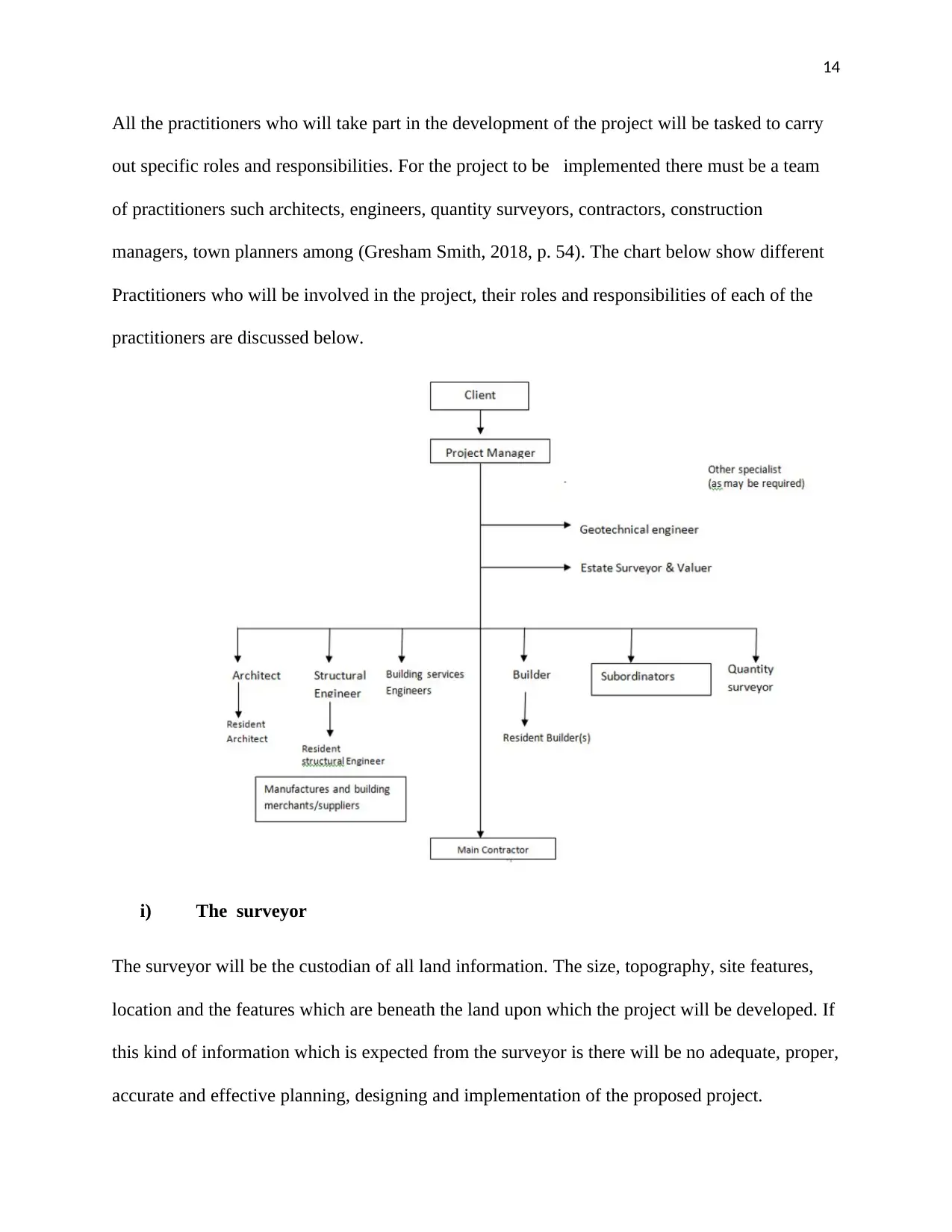
14
All the practitioners who will take part in the development of the project will be tasked to carry
out specific roles and responsibilities. For the project to be implemented there must be a team
of practitioners such architects, engineers, quantity surveyors, contractors, construction
managers, town planners among (Gresham Smith, 2018, p. 54). The chart below show different
Practitioners who will be involved in the project, their roles and responsibilities of each of the
practitioners are discussed below.
i) The surveyor
The surveyor will be the custodian of all land information. The size, topography, site features,
location and the features which are beneath the land upon which the project will be developed. If
this kind of information which is expected from the surveyor is there will be no adequate, proper,
accurate and effective planning, designing and implementation of the proposed project.
All the practitioners who will take part in the development of the project will be tasked to carry
out specific roles and responsibilities. For the project to be implemented there must be a team
of practitioners such architects, engineers, quantity surveyors, contractors, construction
managers, town planners among (Gresham Smith, 2018, p. 54). The chart below show different
Practitioners who will be involved in the project, their roles and responsibilities of each of the
practitioners are discussed below.
i) The surveyor
The surveyor will be the custodian of all land information. The size, topography, site features,
location and the features which are beneath the land upon which the project will be developed. If
this kind of information which is expected from the surveyor is there will be no adequate, proper,
accurate and effective planning, designing and implementation of the proposed project.
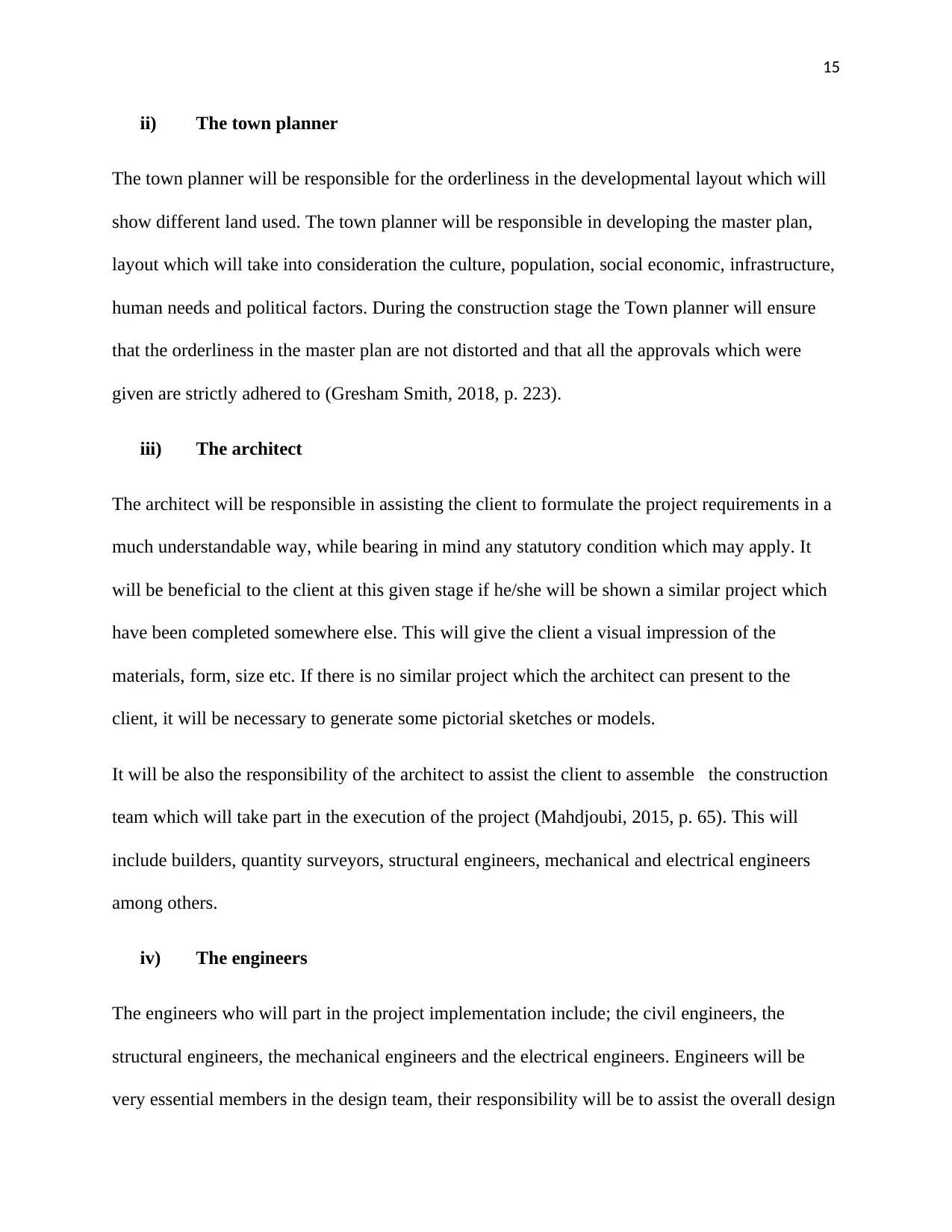
15
ii) The town planner
The town planner will be responsible for the orderliness in the developmental layout which will
show different land used. The town planner will be responsible in developing the master plan,
layout which will take into consideration the culture, population, social economic, infrastructure,
human needs and political factors. During the construction stage the Town planner will ensure
that the orderliness in the master plan are not distorted and that all the approvals which were
given are strictly adhered to (Gresham Smith, 2018, p. 223).
iii) The architect
The architect will be responsible in assisting the client to formulate the project requirements in a
much understandable way, while bearing in mind any statutory condition which may apply. It
will be beneficial to the client at this given stage if he/she will be shown a similar project which
have been completed somewhere else. This will give the client a visual impression of the
materials, form, size etc. If there is no similar project which the architect can present to the
client, it will be necessary to generate some pictorial sketches or models.
It will be also the responsibility of the architect to assist the client to assemble the construction
team which will take part in the execution of the project (Mahdjoubi, 2015, p. 65). This will
include builders, quantity surveyors, structural engineers, mechanical and electrical engineers
among others.
iv) The engineers
The engineers who will part in the project implementation include; the civil engineers, the
structural engineers, the mechanical engineers and the electrical engineers. Engineers will be
very essential members in the design team, their responsibility will be to assist the overall design
ii) The town planner
The town planner will be responsible for the orderliness in the developmental layout which will
show different land used. The town planner will be responsible in developing the master plan,
layout which will take into consideration the culture, population, social economic, infrastructure,
human needs and political factors. During the construction stage the Town planner will ensure
that the orderliness in the master plan are not distorted and that all the approvals which were
given are strictly adhered to (Gresham Smith, 2018, p. 223).
iii) The architect
The architect will be responsible in assisting the client to formulate the project requirements in a
much understandable way, while bearing in mind any statutory condition which may apply. It
will be beneficial to the client at this given stage if he/she will be shown a similar project which
have been completed somewhere else. This will give the client a visual impression of the
materials, form, size etc. If there is no similar project which the architect can present to the
client, it will be necessary to generate some pictorial sketches or models.
It will be also the responsibility of the architect to assist the client to assemble the construction
team which will take part in the execution of the project (Mahdjoubi, 2015, p. 65). This will
include builders, quantity surveyors, structural engineers, mechanical and electrical engineers
among others.
iv) The engineers
The engineers who will part in the project implementation include; the civil engineers, the
structural engineers, the mechanical engineers and the electrical engineers. Engineers will be
very essential members in the design team, their responsibility will be to assist the overall design
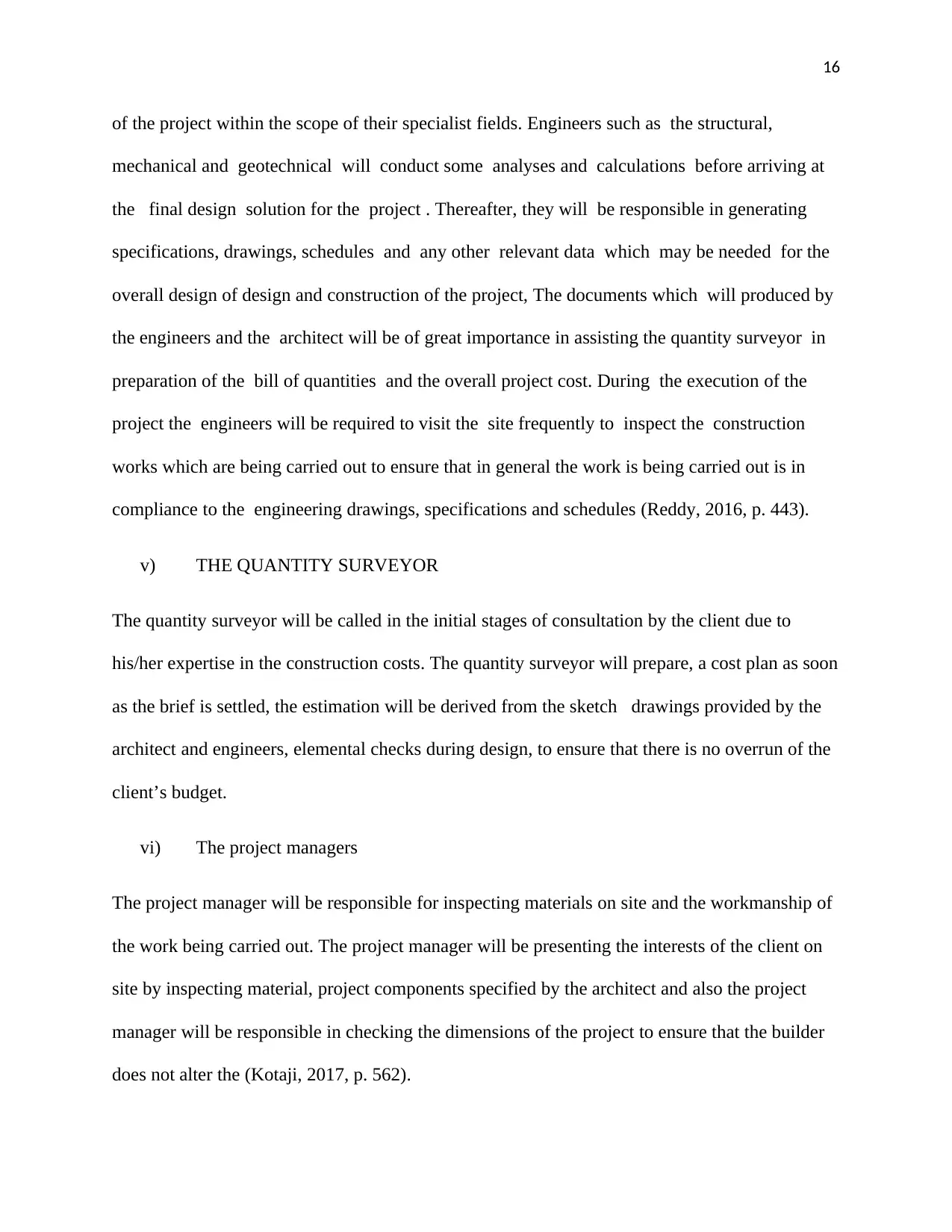
16
of the project within the scope of their specialist fields. Engineers such as the structural,
mechanical and geotechnical will conduct some analyses and calculations before arriving at
the final design solution for the project . Thereafter, they will be responsible in generating
specifications, drawings, schedules and any other relevant data which may be needed for the
overall design of design and construction of the project, The documents which will produced by
the engineers and the architect will be of great importance in assisting the quantity surveyor in
preparation of the bill of quantities and the overall project cost. During the execution of the
project the engineers will be required to visit the site frequently to inspect the construction
works which are being carried out to ensure that in general the work is being carried out is in
compliance to the engineering drawings, specifications and schedules (Reddy, 2016, p. 443).
v) THE QUANTITY SURVEYOR
The quantity surveyor will be called in the initial stages of consultation by the client due to
his/her expertise in the construction costs. The quantity surveyor will prepare, a cost plan as soon
as the brief is settled, the estimation will be derived from the sketch drawings provided by the
architect and engineers, elemental checks during design, to ensure that there is no overrun of the
client’s budget.
vi) The project managers
The project manager will be responsible for inspecting materials on site and the workmanship of
the work being carried out. The project manager will be presenting the interests of the client on
site by inspecting material, project components specified by the architect and also the project
manager will be responsible in checking the dimensions of the project to ensure that the builder
does not alter the (Kotaji, 2017, p. 562).
of the project within the scope of their specialist fields. Engineers such as the structural,
mechanical and geotechnical will conduct some analyses and calculations before arriving at
the final design solution for the project . Thereafter, they will be responsible in generating
specifications, drawings, schedules and any other relevant data which may be needed for the
overall design of design and construction of the project, The documents which will produced by
the engineers and the architect will be of great importance in assisting the quantity surveyor in
preparation of the bill of quantities and the overall project cost. During the execution of the
project the engineers will be required to visit the site frequently to inspect the construction
works which are being carried out to ensure that in general the work is being carried out is in
compliance to the engineering drawings, specifications and schedules (Reddy, 2016, p. 443).
v) THE QUANTITY SURVEYOR
The quantity surveyor will be called in the initial stages of consultation by the client due to
his/her expertise in the construction costs. The quantity surveyor will prepare, a cost plan as soon
as the brief is settled, the estimation will be derived from the sketch drawings provided by the
architect and engineers, elemental checks during design, to ensure that there is no overrun of the
client’s budget.
vi) The project managers
The project manager will be responsible for inspecting materials on site and the workmanship of
the work being carried out. The project manager will be presenting the interests of the client on
site by inspecting material, project components specified by the architect and also the project
manager will be responsible in checking the dimensions of the project to ensure that the builder
does not alter the (Kotaji, 2017, p. 562).
Secure Best Marks with AI Grader
Need help grading? Try our AI Grader for instant feedback on your assignments.
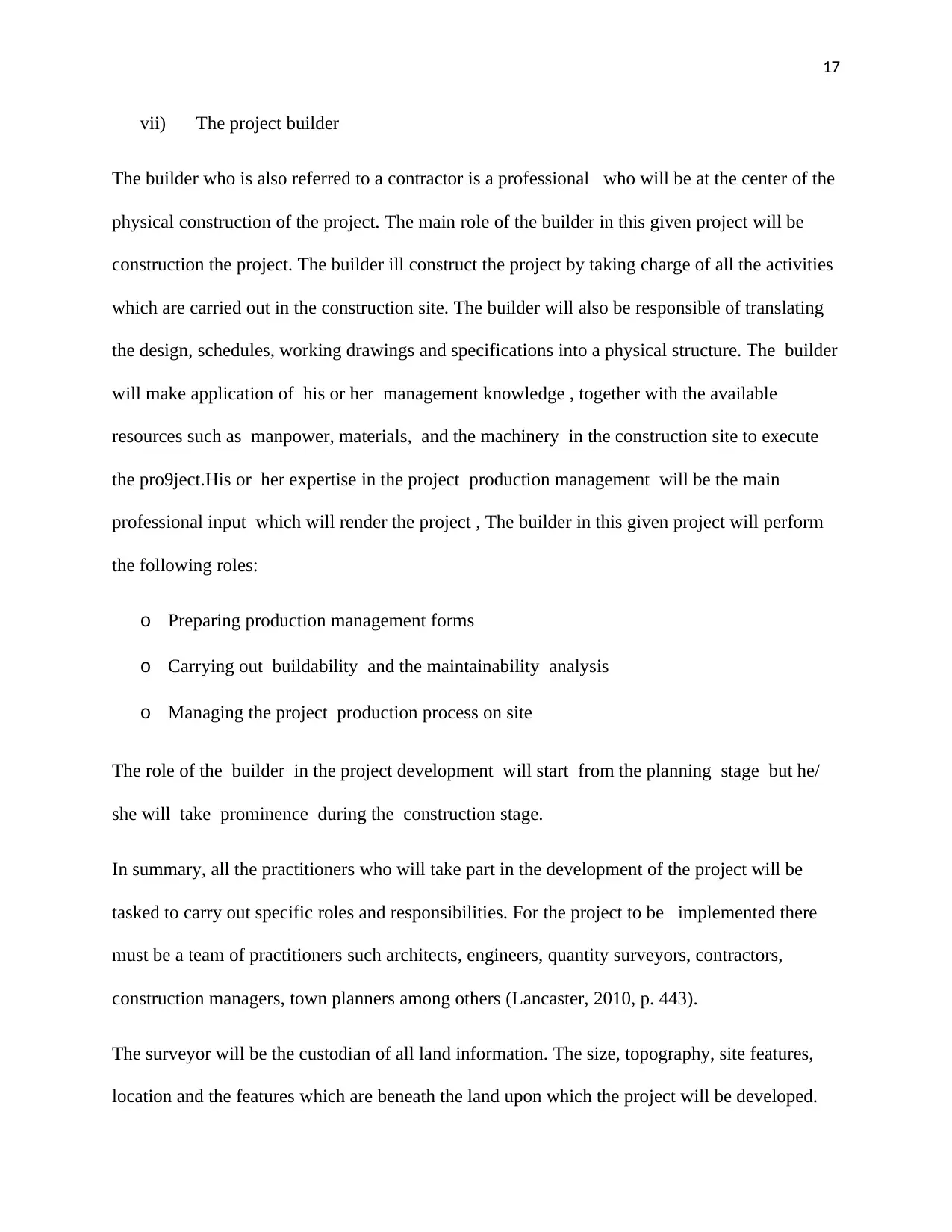
17
vii) The project builder
The builder who is also referred to a contractor is a professional who will be at the center of the
physical construction of the project. The main role of the builder in this given project will be
construction the project. The builder ill construct the project by taking charge of all the activities
which are carried out in the construction site. The builder will also be responsible of translating
the design, schedules, working drawings and specifications into a physical structure. The builder
will make application of his or her management knowledge , together with the available
resources such as manpower, materials, and the machinery in the construction site to execute
the pro9ject.His or her expertise in the project production management will be the main
professional input which will render the project , The builder in this given project will perform
the following roles:
o Preparing production management forms
o Carrying out buildability and the maintainability analysis
o Managing the project production process on site
The role of the builder in the project development will start from the planning stage but he/
she will take prominence during the construction stage.
In summary, all the practitioners who will take part in the development of the project will be
tasked to carry out specific roles and responsibilities. For the project to be implemented there
must be a team of practitioners such architects, engineers, quantity surveyors, contractors,
construction managers, town planners among others (Lancaster, 2010, p. 443).
The surveyor will be the custodian of all land information. The size, topography, site features,
location and the features which are beneath the land upon which the project will be developed.
vii) The project builder
The builder who is also referred to a contractor is a professional who will be at the center of the
physical construction of the project. The main role of the builder in this given project will be
construction the project. The builder ill construct the project by taking charge of all the activities
which are carried out in the construction site. The builder will also be responsible of translating
the design, schedules, working drawings and specifications into a physical structure. The builder
will make application of his or her management knowledge , together with the available
resources such as manpower, materials, and the machinery in the construction site to execute
the pro9ject.His or her expertise in the project production management will be the main
professional input which will render the project , The builder in this given project will perform
the following roles:
o Preparing production management forms
o Carrying out buildability and the maintainability analysis
o Managing the project production process on site
The role of the builder in the project development will start from the planning stage but he/
she will take prominence during the construction stage.
In summary, all the practitioners who will take part in the development of the project will be
tasked to carry out specific roles and responsibilities. For the project to be implemented there
must be a team of practitioners such architects, engineers, quantity surveyors, contractors,
construction managers, town planners among others (Lancaster, 2010, p. 443).
The surveyor will be the custodian of all land information. The size, topography, site features,
location and the features which are beneath the land upon which the project will be developed.
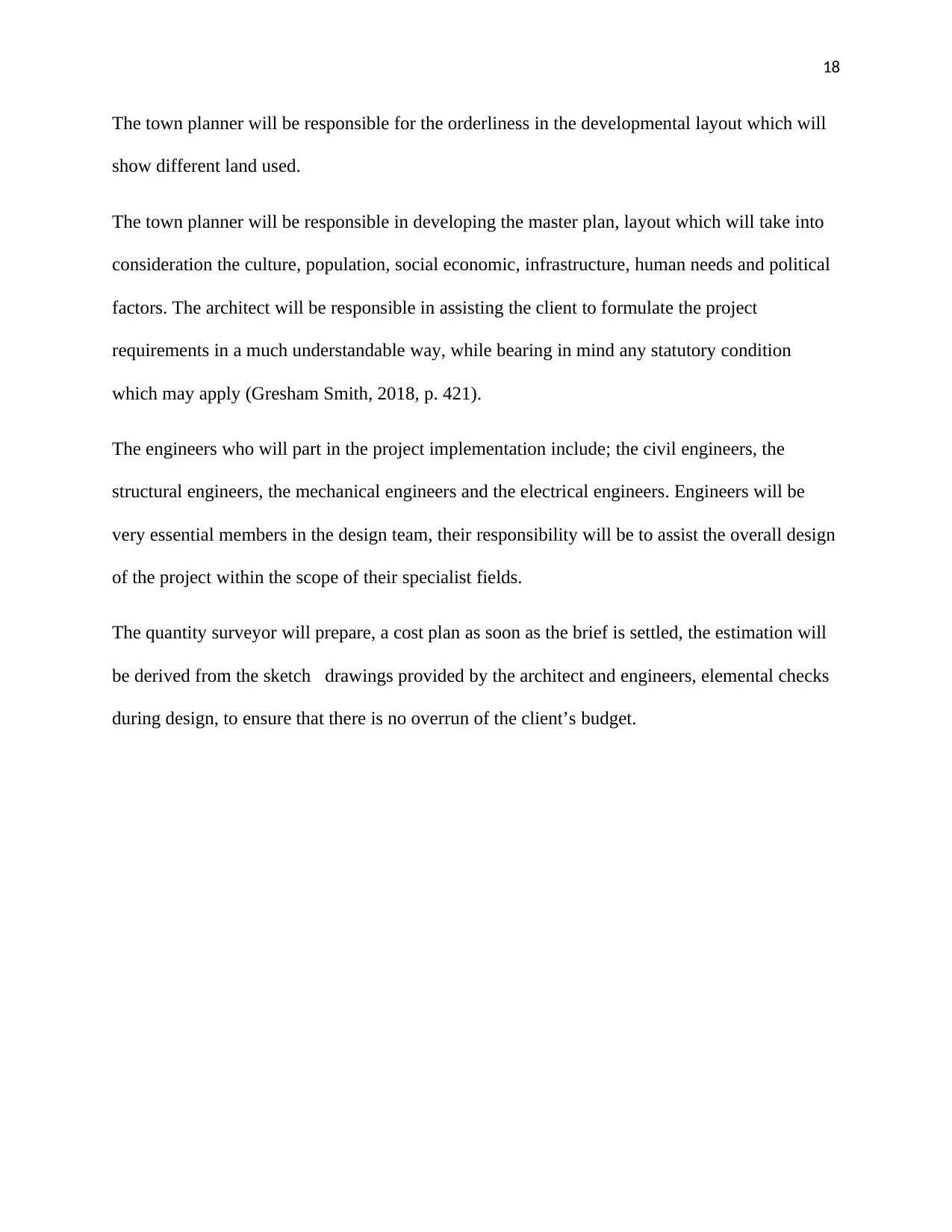
18
The town planner will be responsible for the orderliness in the developmental layout which will
show different land used.
The town planner will be responsible in developing the master plan, layout which will take into
consideration the culture, population, social economic, infrastructure, human needs and political
factors. The architect will be responsible in assisting the client to formulate the project
requirements in a much understandable way, while bearing in mind any statutory condition
which may apply (Gresham Smith, 2018, p. 421).
The engineers who will part in the project implementation include; the civil engineers, the
structural engineers, the mechanical engineers and the electrical engineers. Engineers will be
very essential members in the design team, their responsibility will be to assist the overall design
of the project within the scope of their specialist fields.
The quantity surveyor will prepare, a cost plan as soon as the brief is settled, the estimation will
be derived from the sketch drawings provided by the architect and engineers, elemental checks
during design, to ensure that there is no overrun of the client’s budget.
The town planner will be responsible for the orderliness in the developmental layout which will
show different land used.
The town planner will be responsible in developing the master plan, layout which will take into
consideration the culture, population, social economic, infrastructure, human needs and political
factors. The architect will be responsible in assisting the client to formulate the project
requirements in a much understandable way, while bearing in mind any statutory condition
which may apply (Gresham Smith, 2018, p. 421).
The engineers who will part in the project implementation include; the civil engineers, the
structural engineers, the mechanical engineers and the electrical engineers. Engineers will be
very essential members in the design team, their responsibility will be to assist the overall design
of the project within the scope of their specialist fields.
The quantity surveyor will prepare, a cost plan as soon as the brief is settled, the estimation will
be derived from the sketch drawings provided by the architect and engineers, elemental checks
during design, to ensure that there is no overrun of the client’s budget.
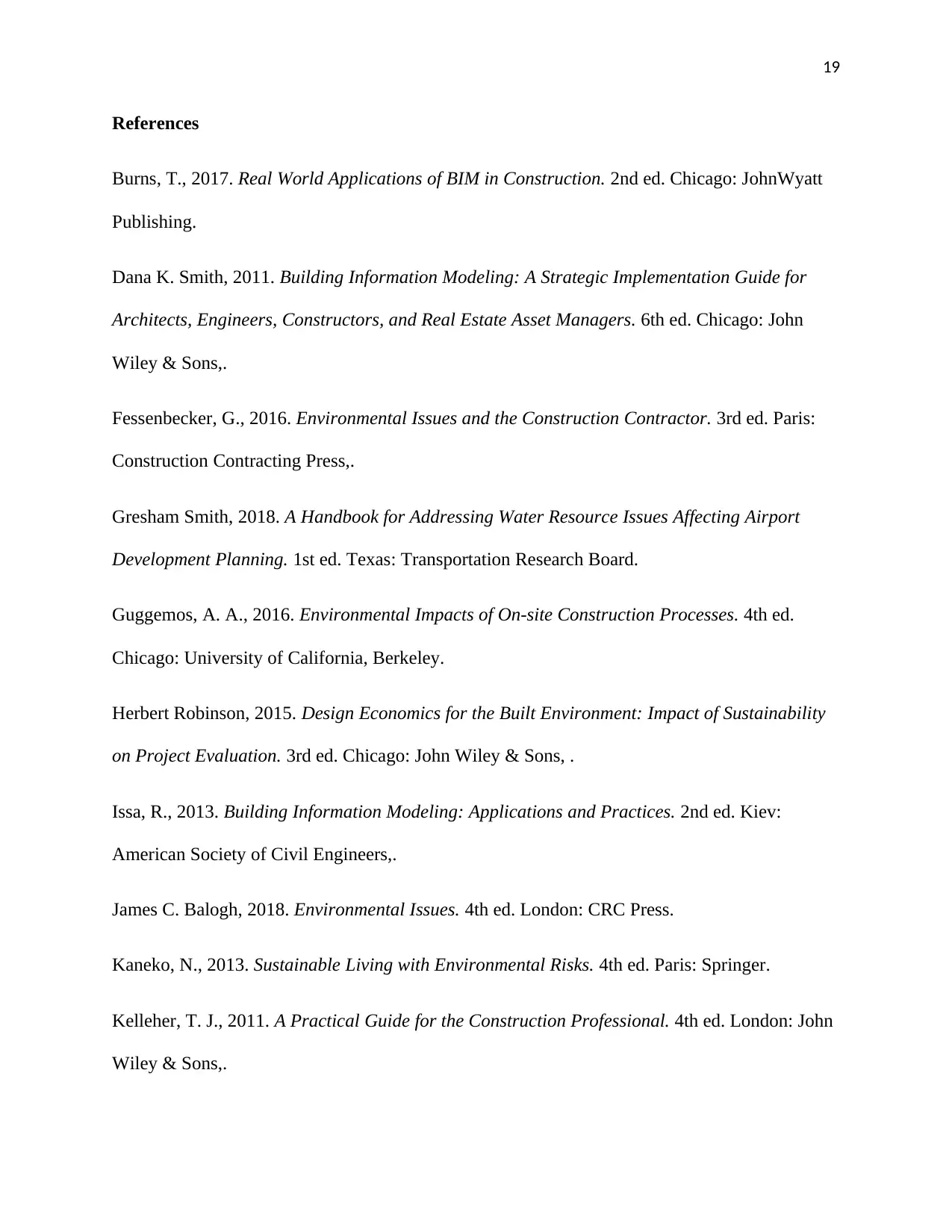
19
References
Burns, T., 2017. Real World Applications of BIM in Construction. 2nd ed. Chicago: JohnWyatt
Publishing.
Dana K. Smith, 2011. Building Information Modeling: A Strategic Implementation Guide for
Architects, Engineers, Constructors, and Real Estate Asset Managers. 6th ed. Chicago: John
Wiley & Sons,.
Fessenbecker, G., 2016. Environmental Issues and the Construction Contractor. 3rd ed. Paris:
Construction Contracting Press,.
Gresham Smith, 2018. A Handbook for Addressing Water Resource Issues Affecting Airport
Development Planning. 1st ed. Texas: Transportation Research Board.
Guggemos, A. A., 2016. Environmental Impacts of On-site Construction Processes. 4th ed.
Chicago: University of California, Berkeley.
Herbert Robinson, 2015. Design Economics for the Built Environment: Impact of Sustainability
on Project Evaluation. 3rd ed. Chicago: John Wiley & Sons, .
Issa, R., 2013. Building Information Modeling: Applications and Practices. 2nd ed. Kiev:
American Society of Civil Engineers,.
James C. Balogh, 2018. Environmental Issues. 4th ed. London: CRC Press.
Kaneko, N., 2013. Sustainable Living with Environmental Risks. 4th ed. Paris: Springer.
Kelleher, T. J., 2011. A Practical Guide for the Construction Professional. 4th ed. London: John
Wiley & Sons,.
References
Burns, T., 2017. Real World Applications of BIM in Construction. 2nd ed. Chicago: JohnWyatt
Publishing.
Dana K. Smith, 2011. Building Information Modeling: A Strategic Implementation Guide for
Architects, Engineers, Constructors, and Real Estate Asset Managers. 6th ed. Chicago: John
Wiley & Sons,.
Fessenbecker, G., 2016. Environmental Issues and the Construction Contractor. 3rd ed. Paris:
Construction Contracting Press,.
Gresham Smith, 2018. A Handbook for Addressing Water Resource Issues Affecting Airport
Development Planning. 1st ed. Texas: Transportation Research Board.
Guggemos, A. A., 2016. Environmental Impacts of On-site Construction Processes. 4th ed.
Chicago: University of California, Berkeley.
Herbert Robinson, 2015. Design Economics for the Built Environment: Impact of Sustainability
on Project Evaluation. 3rd ed. Chicago: John Wiley & Sons, .
Issa, R., 2013. Building Information Modeling: Applications and Practices. 2nd ed. Kiev:
American Society of Civil Engineers,.
James C. Balogh, 2018. Environmental Issues. 4th ed. London: CRC Press.
Kaneko, N., 2013. Sustainable Living with Environmental Risks. 4th ed. Paris: Springer.
Kelleher, T. J., 2011. A Practical Guide for the Construction Professional. 4th ed. London: John
Wiley & Sons,.
Paraphrase This Document
Need a fresh take? Get an instant paraphrase of this document with our AI Paraphraser
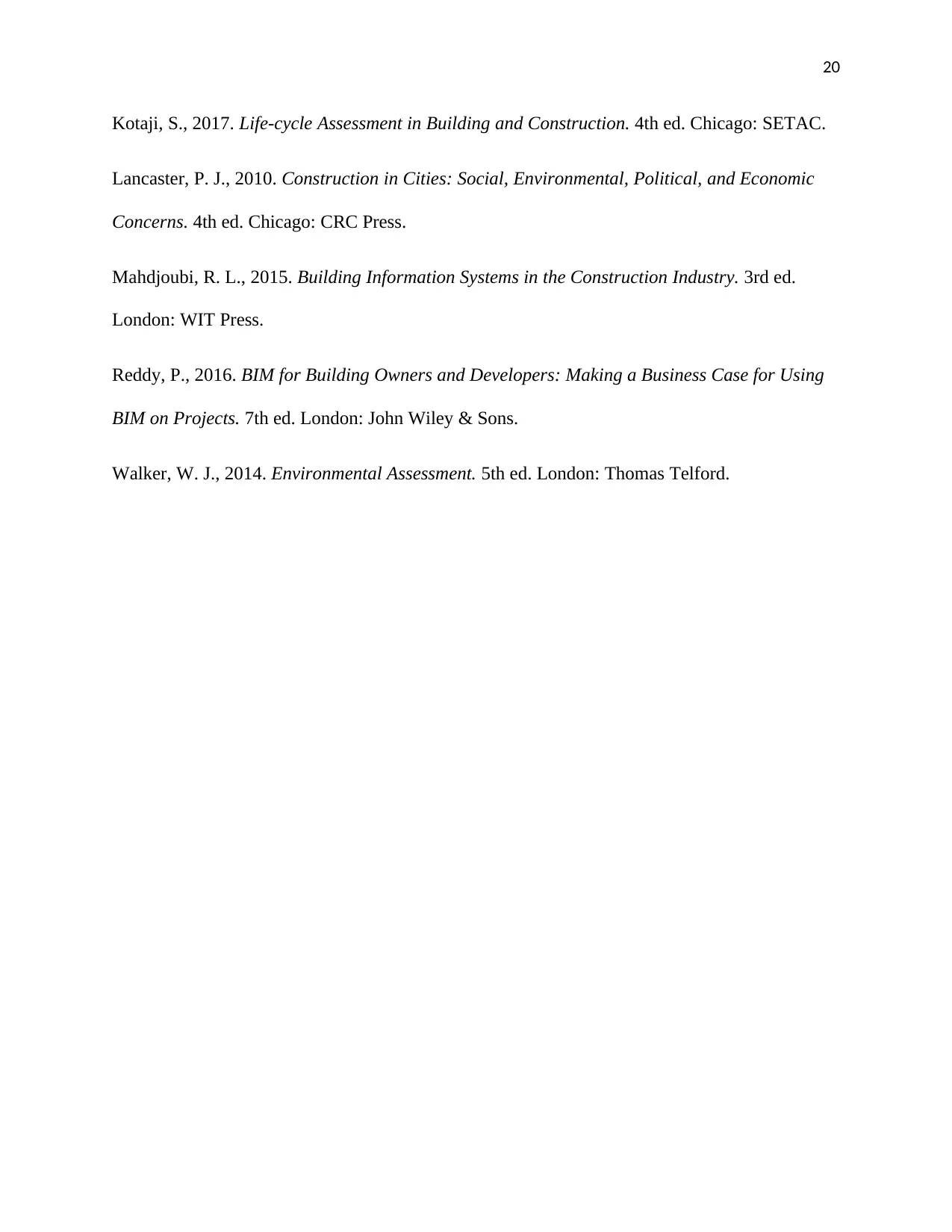
20
Kotaji, S., 2017. Life-cycle Assessment in Building and Construction. 4th ed. Chicago: SETAC.
Lancaster, P. J., 2010. Construction in Cities: Social, Environmental, Political, and Economic
Concerns. 4th ed. Chicago: CRC Press.
Mahdjoubi, R. L., 2015. Building Information Systems in the Construction Industry. 3rd ed.
London: WIT Press.
Reddy, P., 2016. BIM for Building Owners and Developers: Making a Business Case for Using
BIM on Projects. 7th ed. London: John Wiley & Sons.
Walker, W. J., 2014. Environmental Assessment. 5th ed. London: Thomas Telford.
Kotaji, S., 2017. Life-cycle Assessment in Building and Construction. 4th ed. Chicago: SETAC.
Lancaster, P. J., 2010. Construction in Cities: Social, Environmental, Political, and Economic
Concerns. 4th ed. Chicago: CRC Press.
Mahdjoubi, R. L., 2015. Building Information Systems in the Construction Industry. 3rd ed.
London: WIT Press.
Reddy, P., 2016. BIM for Building Owners and Developers: Making a Business Case for Using
BIM on Projects. 7th ed. London: John Wiley & Sons.
Walker, W. J., 2014. Environmental Assessment. 5th ed. London: Thomas Telford.
1 out of 20
Related Documents
Your All-in-One AI-Powered Toolkit for Academic Success.
+13062052269
info@desklib.com
Available 24*7 on WhatsApp / Email
![[object Object]](/_next/static/media/star-bottom.7253800d.svg)
Unlock your academic potential
© 2024 | Zucol Services PVT LTD | All rights reserved.





